Peninsula State Park, Fish Creek, Wisconsin
Today, we had quite a few of those!
We started our day quite early – leaving home at 6:30am. We had a ferry to catch, so we wanted to be early in case it would fill up. We’re actually taking two ferries today to get to our final destination – Rock Island. But first, we have to get to Washington Island.
It’s a good thing Blaine was a Boy Scout – always be prepared and all that, because even though we arrived at the first ferry 40 minutes early, the line to get on was already filling up; mostly because of the two delivery trucks that were waiting to board. So it turned out we weren’t all that early after all.
It cost us $75. But remember, that’s for two ferries for two people round trip and the Jeep for one ferry round trip. The Jeep’s not allowed on Rock Island. No vehicles and no bicycles either. The only transportation allowed is your two feet. So you take your car across from the tip of the Wisconsin peninsula to Washington Island, take 20 minutes to drive across the small island to the opposite side, park your car for free and hop onto the smaller Rock Island ferry.

Waiting for the Washington Island Ferry
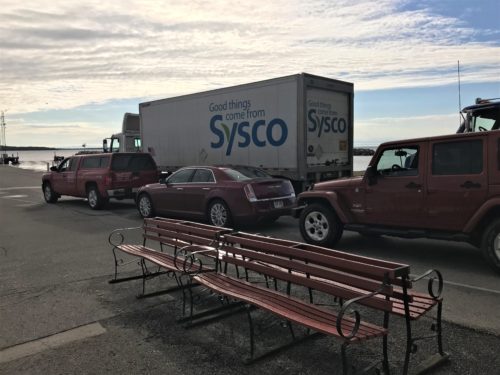
There are two trucks this size waiting . . .
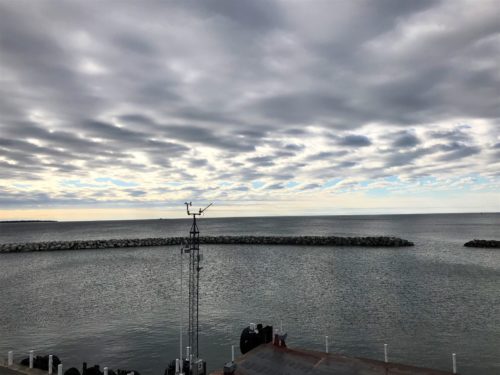
Overcast skies make for gray water

It arrived right on time, but we had to wait for it to empty first.
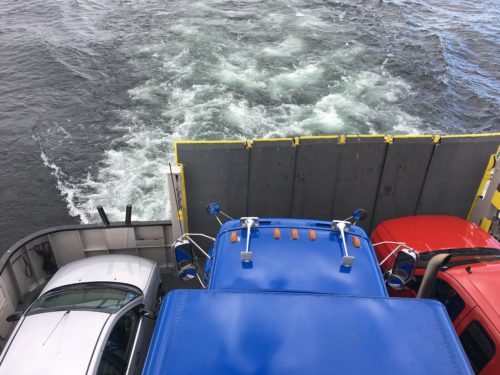
The guys are really good at packing us on here!
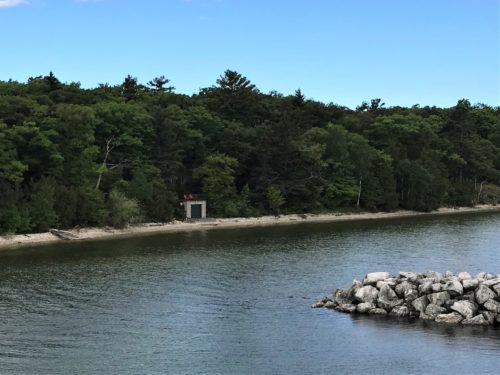
These two red chairs reminded us of the ones we saw. Remember?
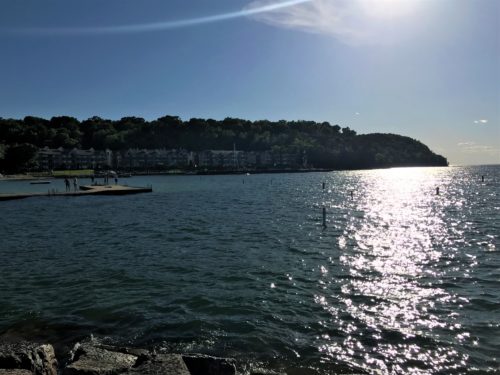
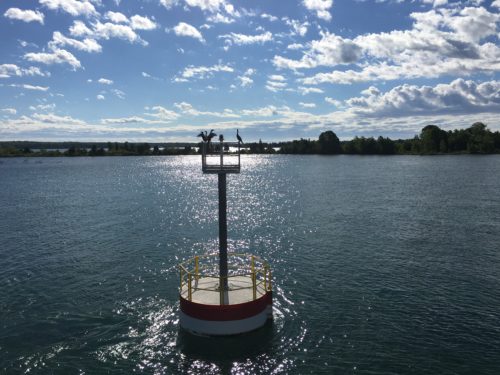
Cormorants drying their wings.
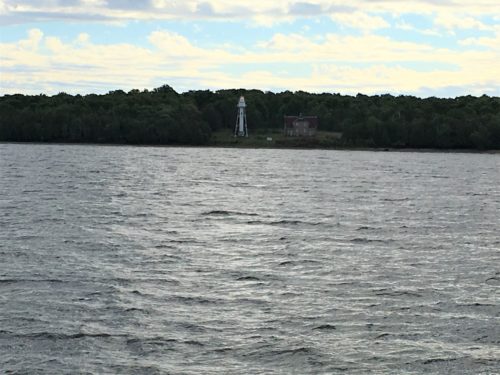
This is the closest we’ll get to this lighthouse. No access from land.
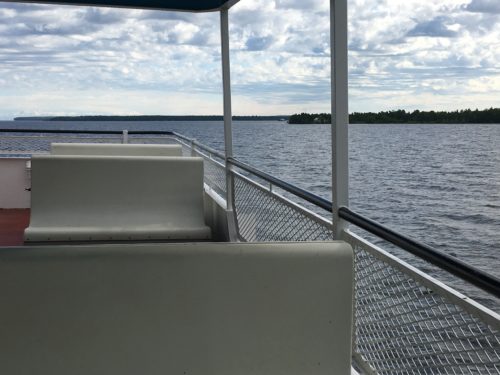
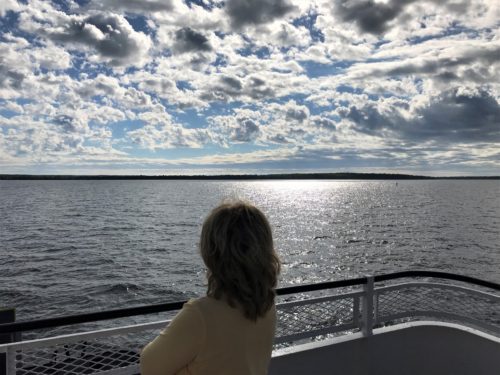
Watching the clouds break up. Yeah!
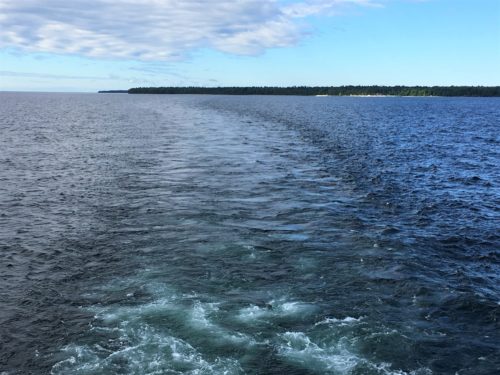
Can you see the line?
Gray on the left and blue on the right?
Waaaay cool!
The left still has clouds, the right has very few.
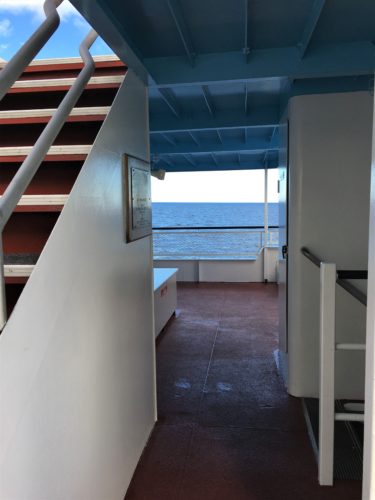

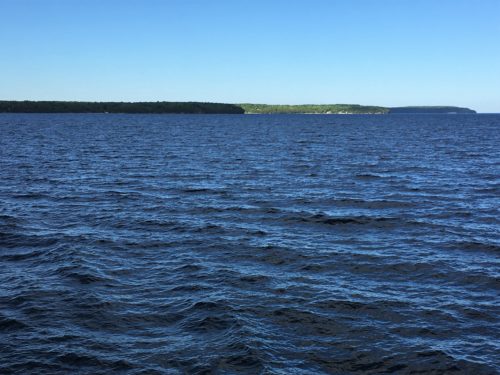
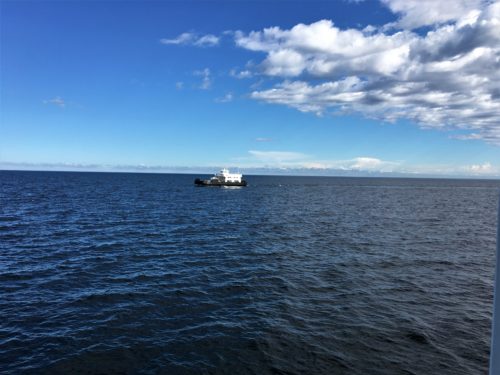
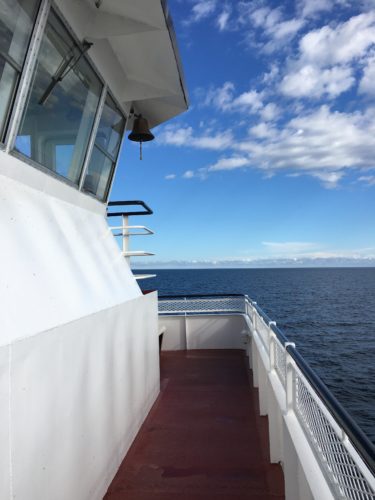
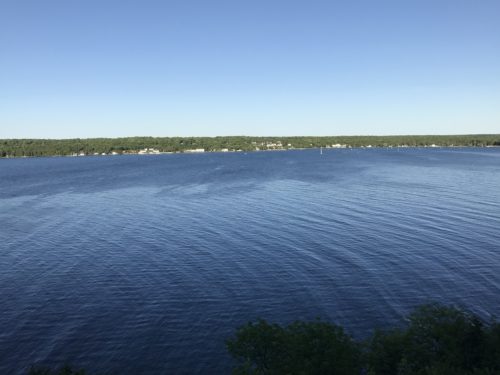
Washington Island
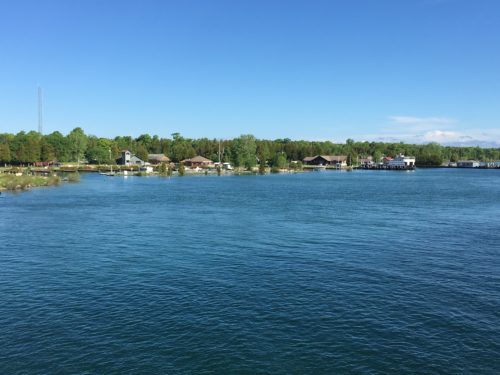
Washington Island
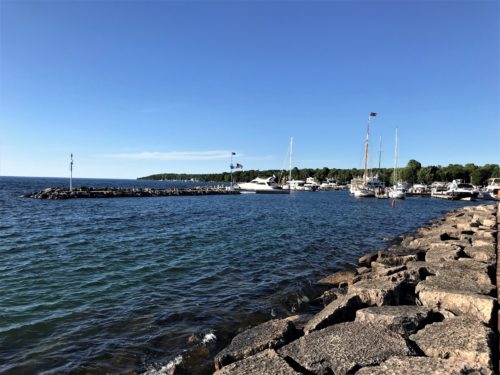

The first ride took about 40 minutes. The second, to Rock Island, was much shorter and crossed over “Death’s Door”. Thank goodness we made it safely!
This passage between the islands of Washington and Rock is only six miles wide. Here’s what the Door County (the county that encompasses almost all of the Wisconsin Peninsula) website says:
History of Death’s Door
So where does the name Door County come from? You can trace it to the area’s most dangerous, mythical feature – Porte des Morts, or as it’s now called, Death’s Door.
The strait linking Lake Michigan and Green Bay, between the tip of the peninsula and Washington Island, was once one of the most notorious, treacherous stretches of water on the Great Lakes.
The name has been traced to a battle between rival Indian tribes in the seventeenth century by both an early government surveyor and historian Hjalmar Holand.
It was a calm night on the waters of Lake Michigan when a group of Potawatomi Indians set out from the islands north of the Door County peninsula to attack the Winnebago Indians on the mainland. While the historic records disagree on the some of the details, all accounts agree that the waters were calm when the Potawatomi warriors left their islands, but abruptly, the weather turned bad, capsizing canoes and trapping warriors in an onslaught near the the rocky shore of what is now Ellison Bay.
Meanwhile, a group of Winnebago warriors who were sent to attack the Potawatomi villages on the islands also got caught in the dangerous waters. They were never heard from again. In all, hundreds of warriors died, giving the thin stretch of water its name.
In the centuries since, Death’s Door’s reputation for rough waters, unpredictable weather and hidden shoals have made it something of a legend with shipwrecks and accounts of lost lives to back it up.
French explorers named the passage after hearing the Native American accounts and sailing the waters themselves. Some say that the French named the passage to discourage British exploration and fur traders through the strait. After all, it was the only way to get from the trading post at modern-day Green Bay to the rest of the Great Lakes.
Whether any of these accounts is absolutely true is unclear, but none will deny that it is home to scores of shipwrecks, perhaps the most of any freshwater in the world.
The passage claimed 24 sailing vessels between 1837 and 1914 and nearly 40 in the nearby waters in the same period. The destruction was so apparent that it contributed to the decision to build the canal through Sturgeon Bay in 1881. Not only could a ship cut 100 miles off their journey, but they could avoid the swirling waters and dark memories.
While the legend is still shrouded in mystery, it has lived on in the culture of the county. It has inspired the name of beer, spirits and even a barbeque festival on Washington Island each August.
For more than 75 years, the Washington Island Ferry Line has made it possible for locals and visitors to safely cross Death’s Door. Make your reservation to cross through the door that has claimed the lives and ships of so many through the county’s history.
There were several places we wanted to visit on Washington. First up was the Stavkirke.
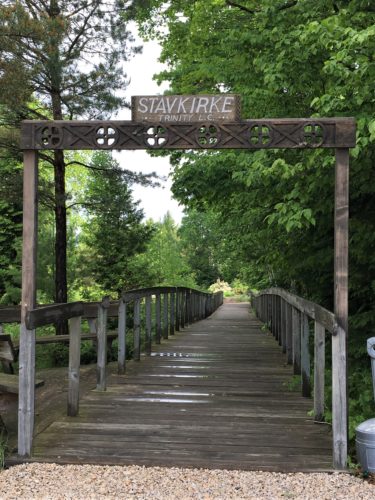
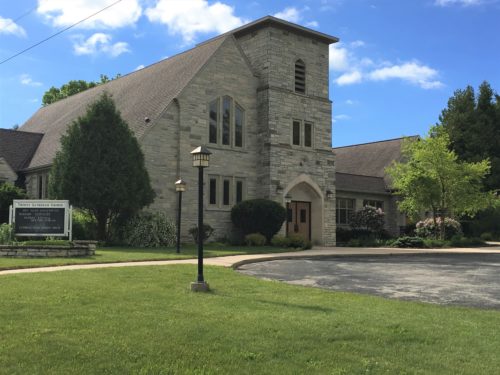
This is the Lutheren church that’s across the street.
We thought it odd that there’s no steeple.
I tried and tried to find out how to pronounce this, but either no one knows, or it’s supposed to be obvious. Not speaking a single, solitary word of Norwegian, I haven’t a clue. What I can tell you is that often these places are called a Stav (sounds like ‘stay’) Church (so called because it’s built with vertical posts), so maybe the ‘kirke’ part means church? Anyway. . .
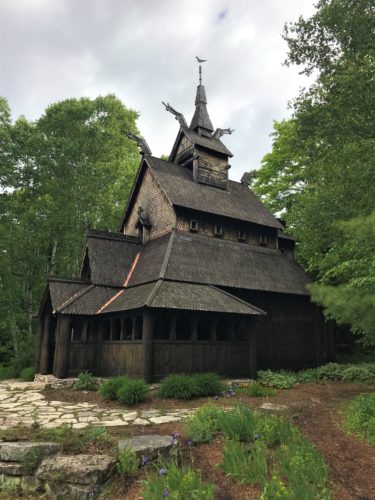
Now there’s something you don’t see every day!
This particular one was begun by Trinity Evangelical Lutheran Church in 1991 and completed in 1995 with mostly volunteer labor. The bell tower and dragon heads were added in 1999. It’s a replication of an ancient style of church construction that was common in Norway during medieval times. That’s why it has a blend of paganism (dragons, etc.) and Christianity. The church this one is patterned after one built in 1150AD. It’s all wood with tongue and groove joints.
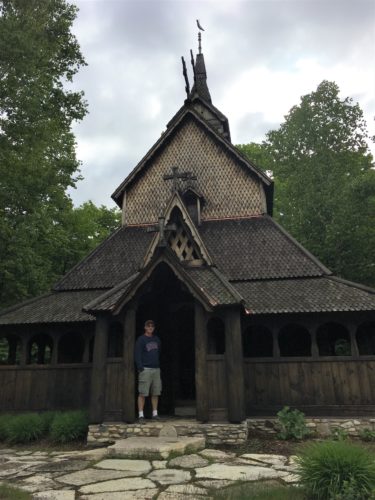
The outside alcoves that run around the front and sides of the building are called ‘ambulatories” and were for storing your weapons while you were in church, and also for people who were sick or impoverished. They weren’t allowed inside. The sick, I understand. Impoverished, haven’t a clue.
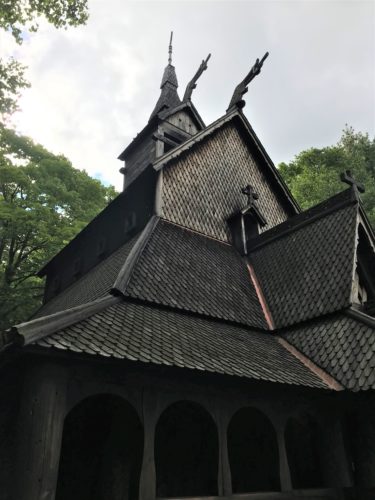
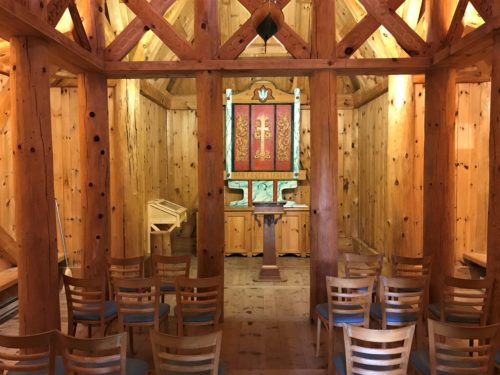
The inside of the chapel
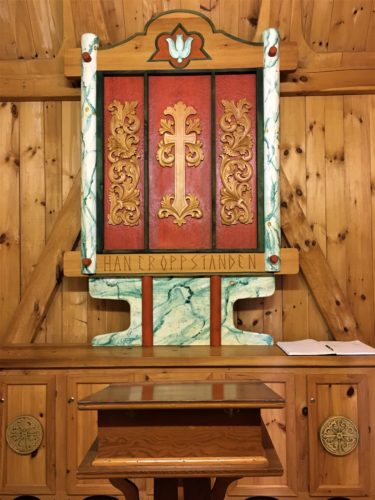
Words on the altar:
Han er oppstanden means: “He is standing above us” or “He is Risen”
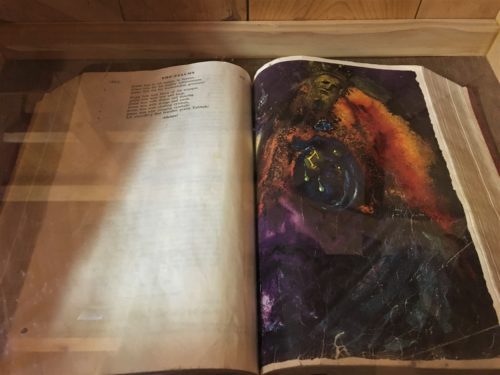
Jerusalem Bible
Donated by Rev. John Zeile in 1995.
FYI – some of his paintings have sold in the multi-millions.
Illustrations by Salvador Dali.
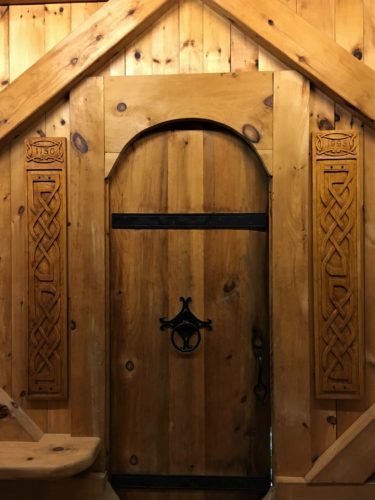
This is a side door.
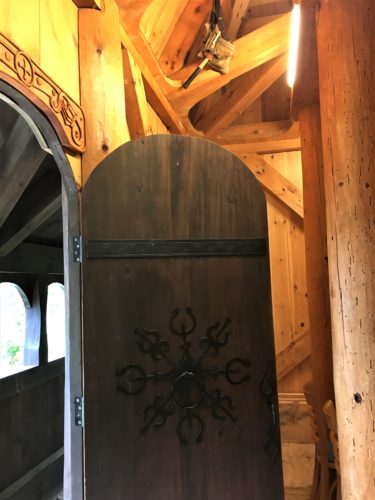
The suspended tool belt is a memorial to a worker who died before construction was complete.
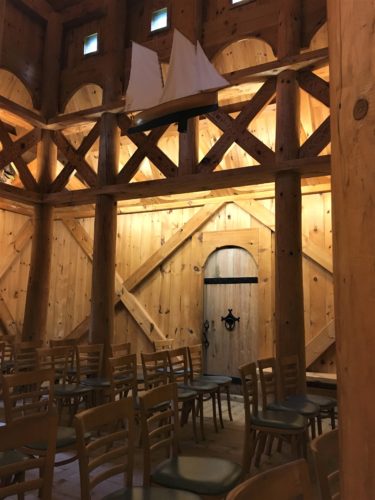
The boat suspended from the ceiling is a model of a mackinaw schooner; a working, sailing vessel popular for fishing and transporting goods across the lake in the mid to late 1800’s.
And no. I’m not sure why it’s in here. I’m guessing because of the sailing history of the Norwegians.

The dragons around the roof are from a design in a stavkirke book. Somehow, they’re supposed to combine paganism and Christianity. Don’t know how that works . . .
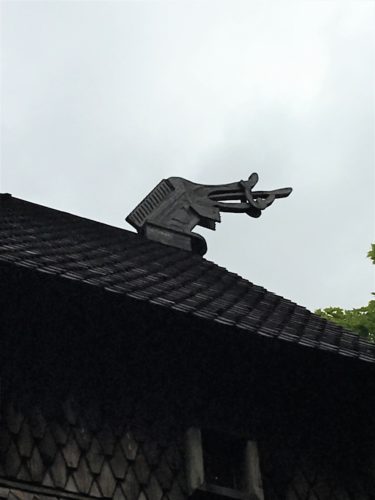
It was an unusual, but pretty place.

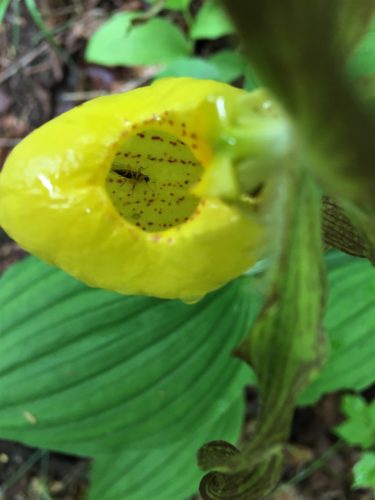



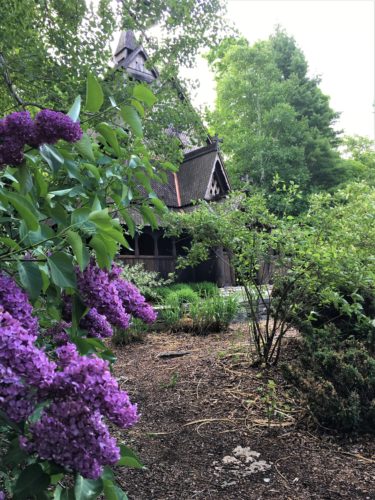

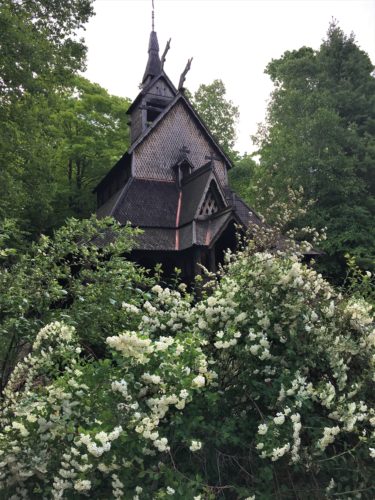
Next, we stopped at The Historic Island Dairy. I was pretty sure there was nothing to eat here – not even ice cream if you can believe it! Everything I’d read talked about lavender and hosting wedding receptions. Sure enough, not much here. And since the lavender wasn’t in bloom, all we saw was dried stuff.
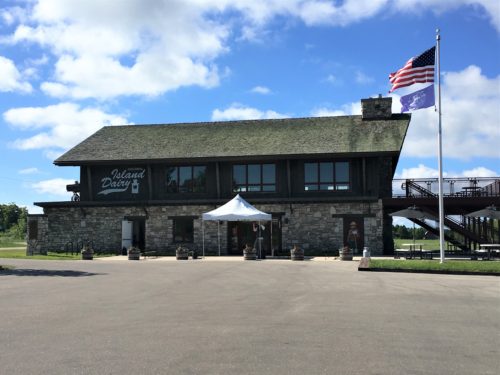
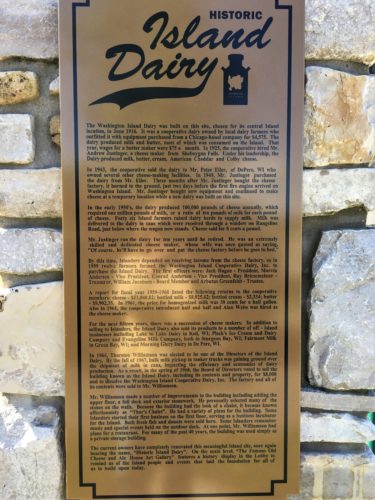
You can zoom in and read it all if you want, but essentially, it says the site began as a co-op dairy farm for milk and butter in 1916. They started making cheese in 1925, and became a private dairy in 1943.
It changed hands several years, and for the past 40 years it was used for storage.
The new owners grow lavender and host wedding receptions and other events.
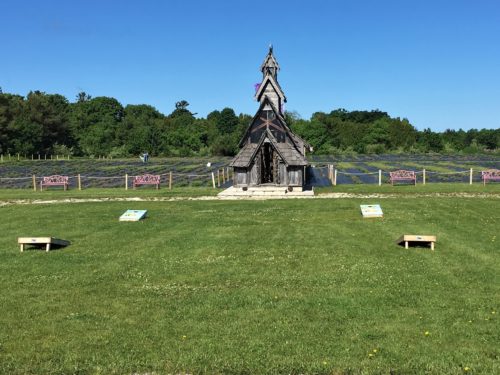
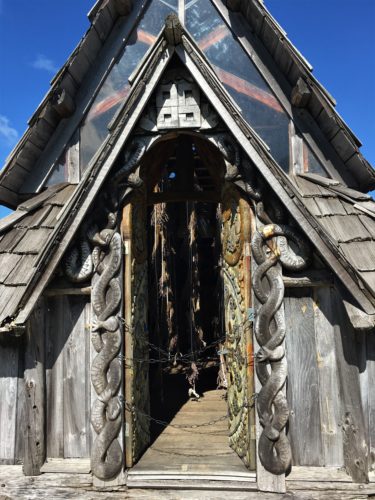
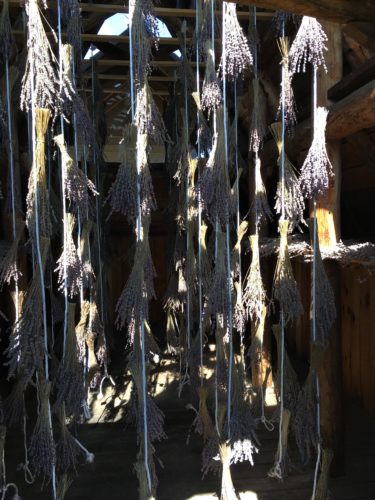

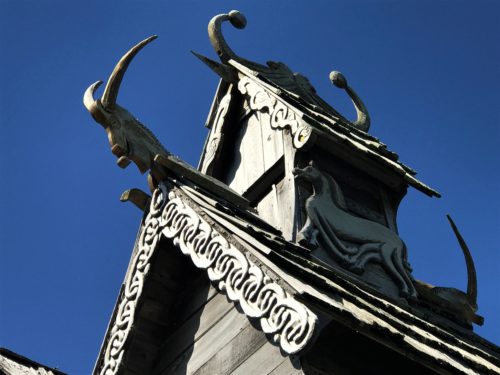
More odd carvings on the roof.
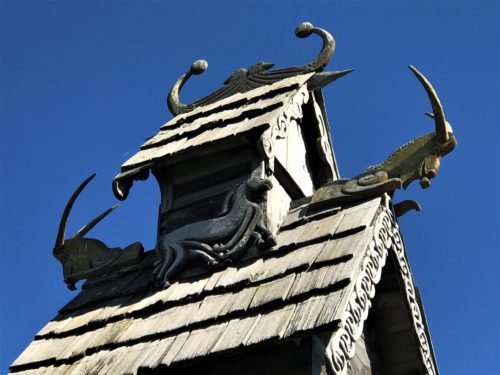
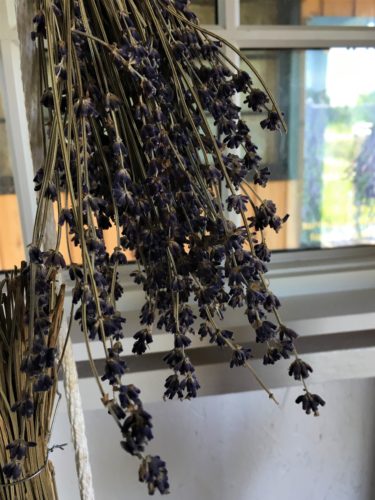
Something else of note: This island is about 35 square miles with just over 700 full-time residents and there are no traffic lights on the entire island, and not many stop signs.
Now there’s something you don’t see every day!
On to the Washington Island Observation Tower. We had to take a total of 185 steps to get up to the advertised 360-degree view of the island – 120 to get there, and another 65 to climb to the top. Whew! It’s amazing how quickly you lose your conditioning!
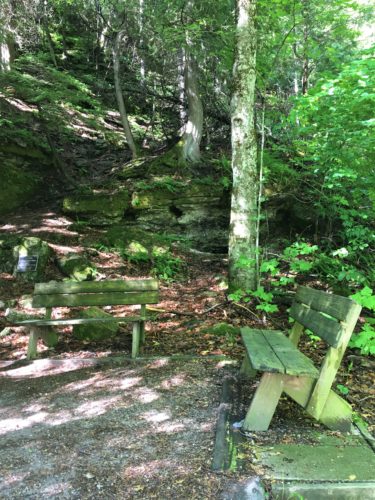
Near the steps
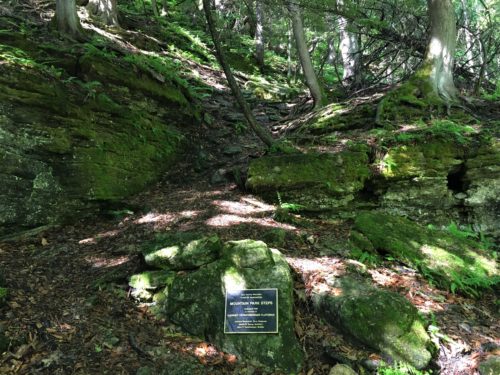

Yep. All the way up there – – and more you can’t see.
This is just to get to the tower!
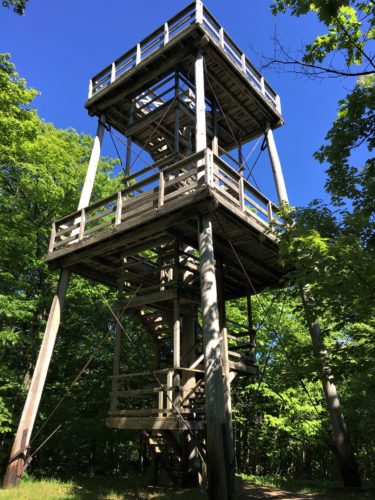
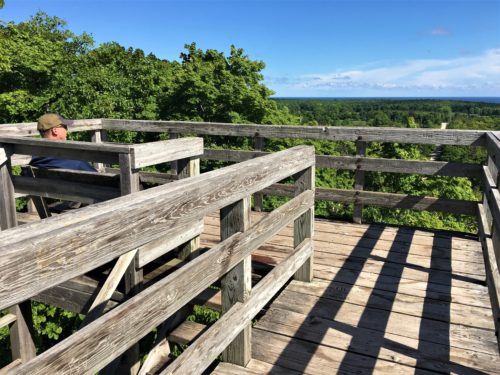

It sure was beautiful up here!
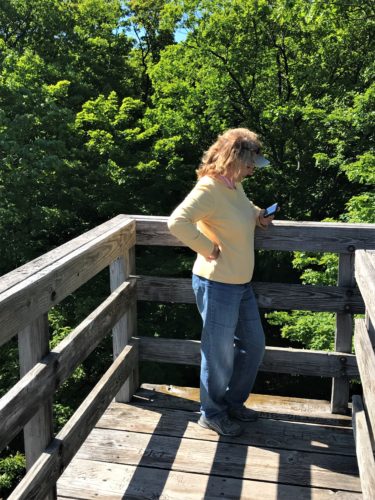
Checking the video I took.
Now there’s something you don’t see every day – a 360 degree observation tower that’s been allowed to be surrounded by trees on three sides!
Then there was Schoolhouse Beach, so named because in the 1850’s there was a school here.
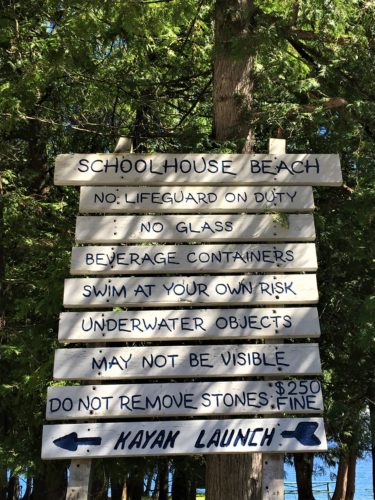
Simply gorgeous!!
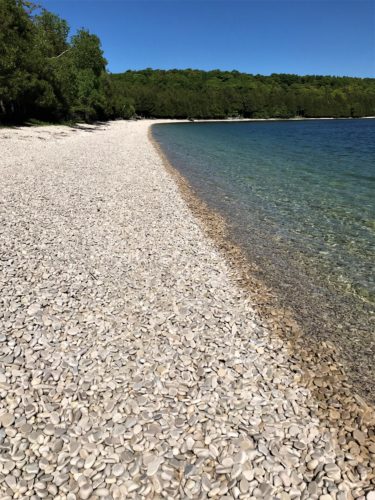

This is a panoramic Blaine took.
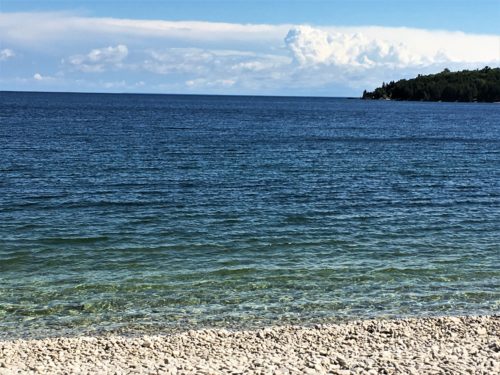
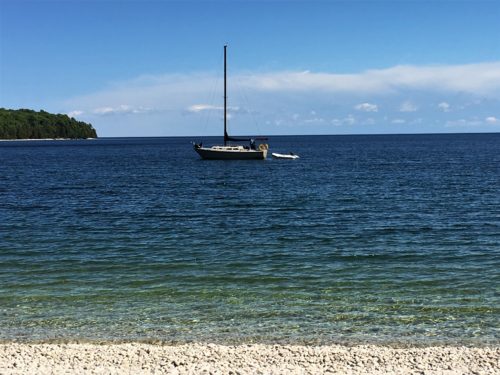
We visited this particular beach because of the things we’d read about it – namely (besides it’s beauteous splendor) it’s rocks.
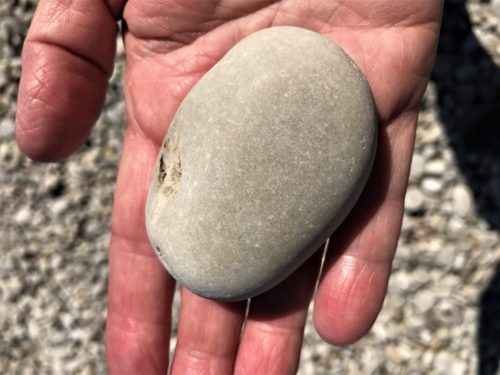
You’re probably wondering about the rocks. They’re so special, it’ll cost you $250 to take one home!
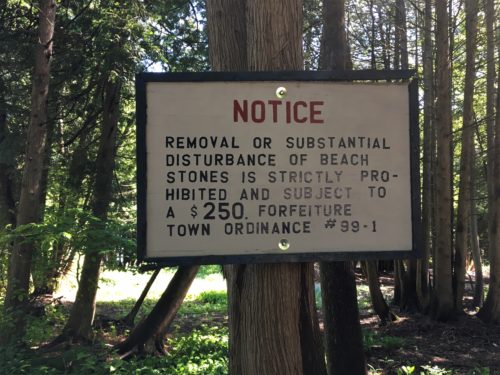
Now there’s something you don’t see every day!
According to the information boards, this is one of only 5 beaches in the world with this type of rock formation – rounded and perfectly smooth limestone and absolutely no sand particles.
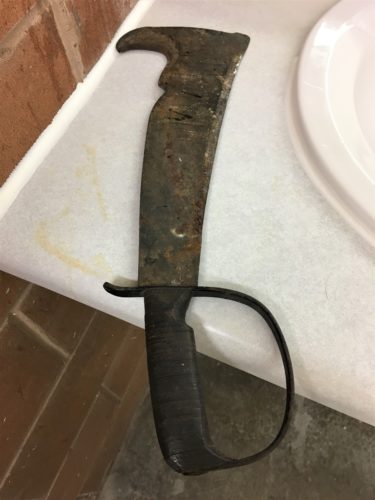
This was in the women’s restroom at Schoolhouse.
Now, there’s something you don’t see every day!
YIKES! Time to move on!
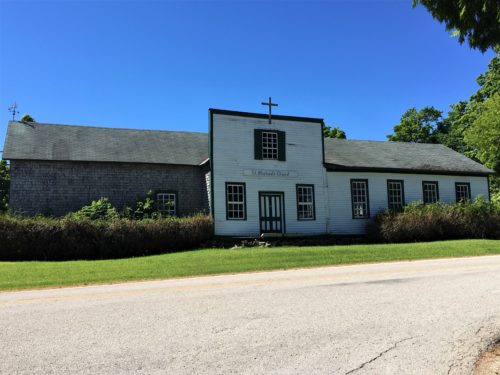
This church was across the street from Schoolhouse beach.
Now we come to the Jacobsen Museum.
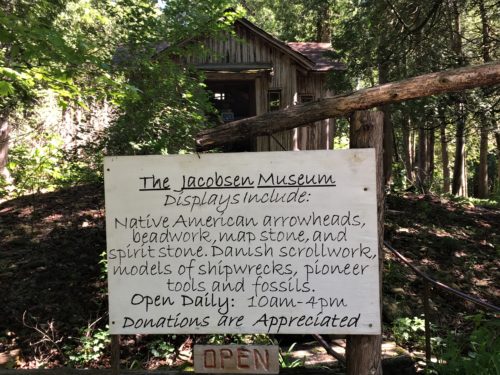
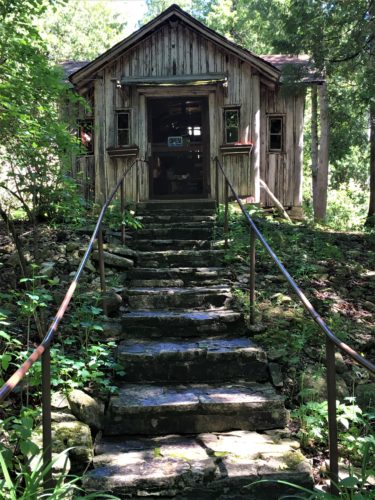
Arguably one of our favorite stops of the day, which on the surface seems a little strange considering the size and condition of this tiny place. I think what made it special was the woman who was manning it today. Her name was Jeannie. Jeannie is pushing 80, if not past and she grew up here. She told us stories of running off to Rock Island and visiting Mr. Jacobsen and being a switchboard operator beginning at the age of 18. How wonderful to hear her talk! And she has this sweet humbleness about her that caused her to be shocked when I asked to take a picture with her – then after, she asked if the camera was still working. 😊
Outside first:


The rudder from the steamer Louisiana that grounded in Washington Harbor in November 1913.
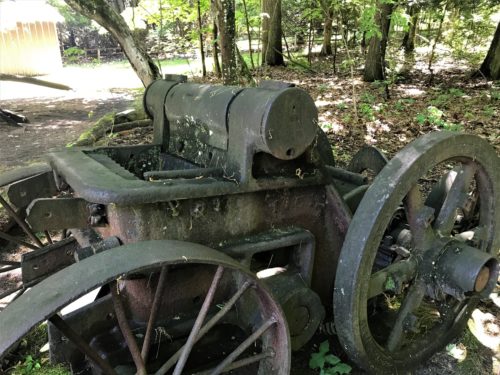
A rock crusher used on Rock Island to crush large rocks into gravel.
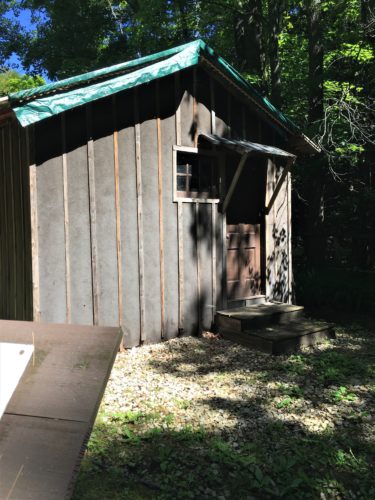
Thorstein’s Study Cabin
Obviously still being restored.


Thorstein Veblen
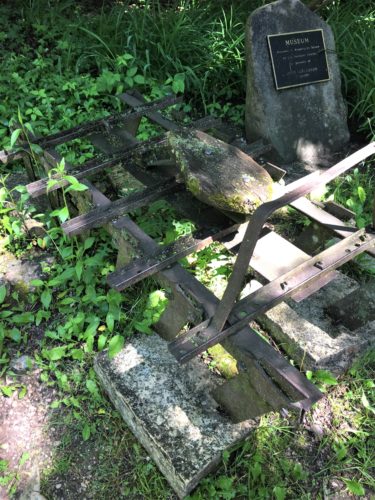
An ice sled
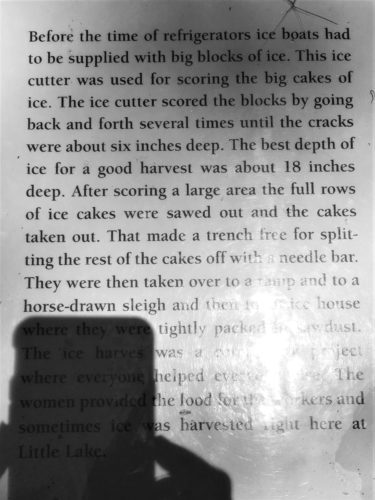
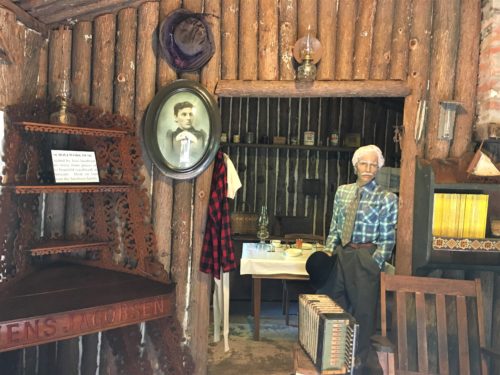
This mannequin is supposed to be Jens.
Strangely, I could find no photographs of him. Hmmm…
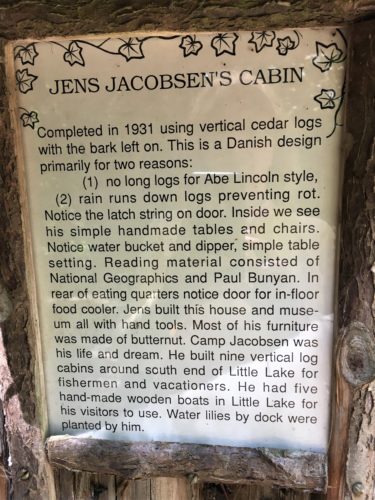
We soon discovered what a remarkable man Jens was, both from Jeannie and also from the various signs and things around the museum. Quite a renaissance man!
This is the poem he wrote to advertise his museum that began as a place to showcase Indian artifacts:
Gone is his wigwam
From the village site away.
Gone, his canoe
From the Lake and the Bay.
Gone, the papooses;
Gone, the Young and old –
Only through his relics,
The story is told.
To appreciate them,
You must see ‘em.
They are on display
At Jacobsen’s Museum.
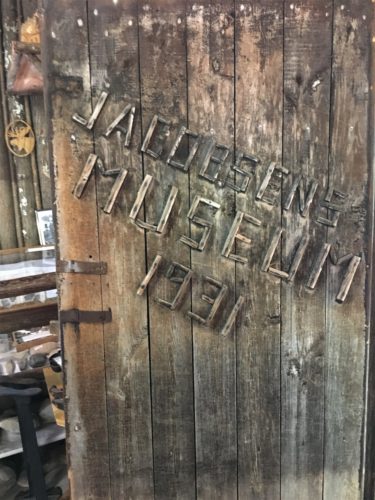
This is the front door.

Jens Jacobsen made all the ships and scrollwork pieces we took pictures
of.
The sails are birch bark.
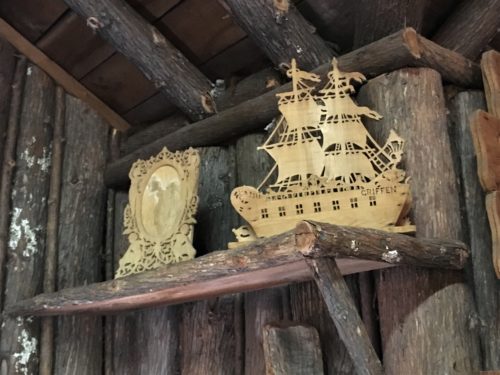
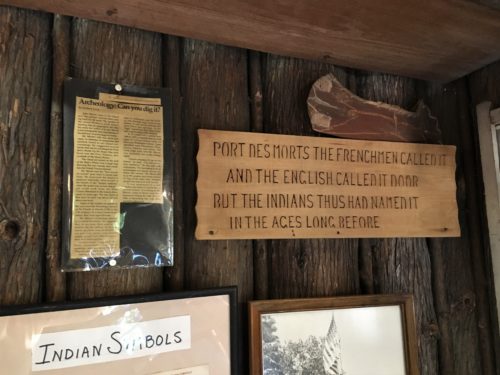
Another example of his poetry.
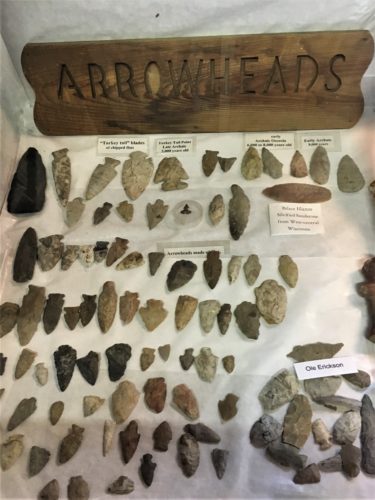
According to Jeannie, most of these were found on or near the property.
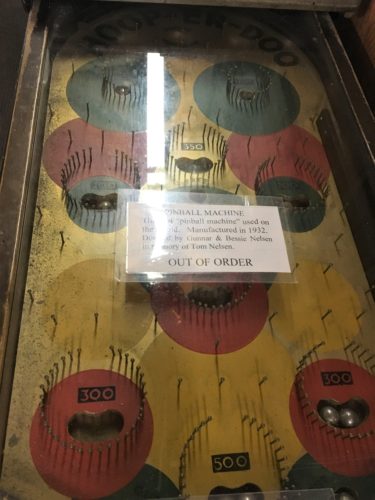
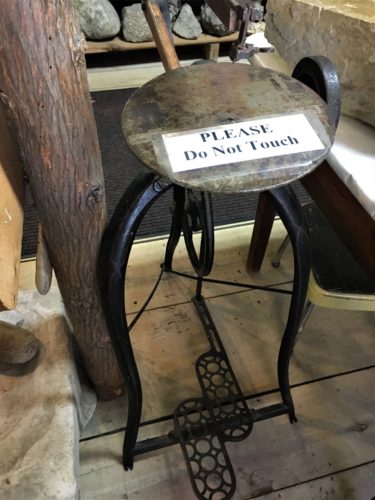
This is a scrollwork saw table. She went into detail about how it worked.
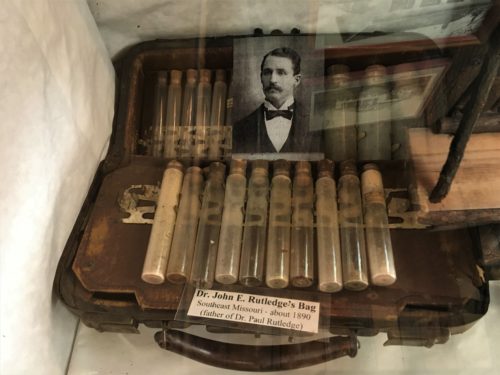
This was interesting!
They had the son’s bag as well, but the lighting was so reflective, I couldn’t take a picture. : (
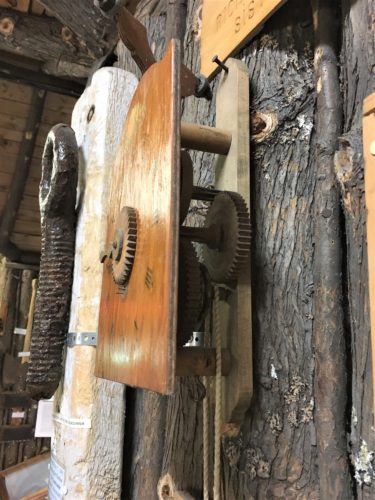
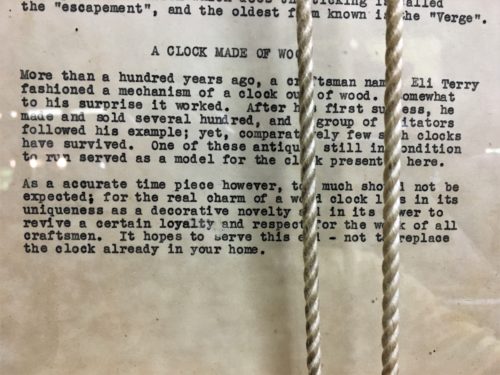
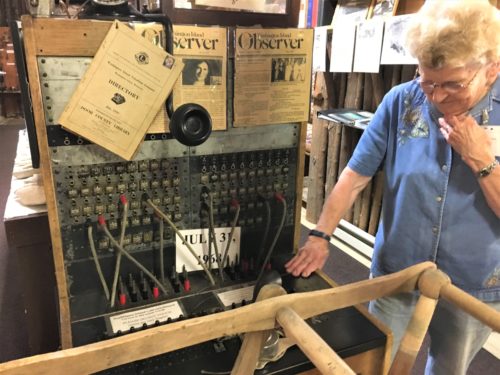
There’s Jeannie and her switchboard! She told us stories of how to use it, party lines and and couple of ornery ladies in the community who liked to start rumors (aka lies) just to see how fast and how far they’d spread. : )
Now there’s something you don’t see everyday!
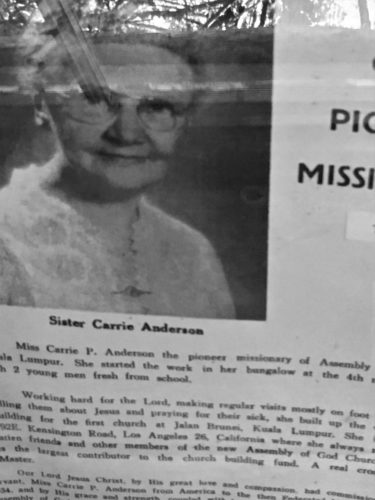
This woman was from the area and was a missionary to China.

Jeannie spent several years trying to find out what the writing on this cloth said.
Once she got two answers that were the same, she went with that for a translation. : )
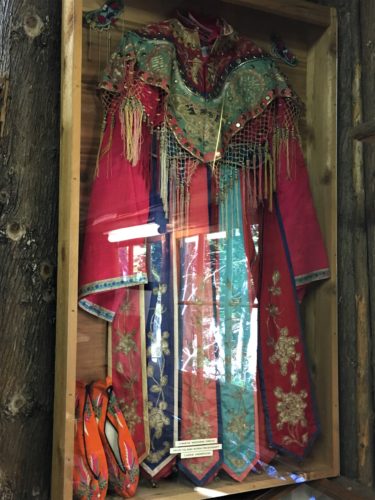
A Chinese wedding dress given to Sister Anderson.
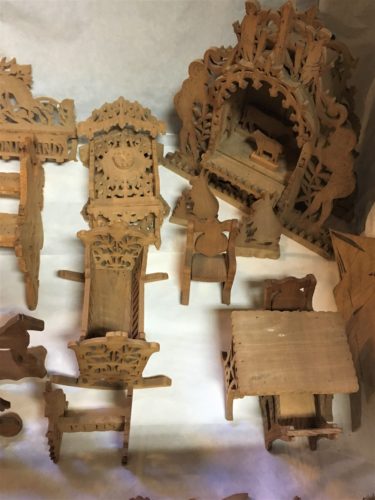
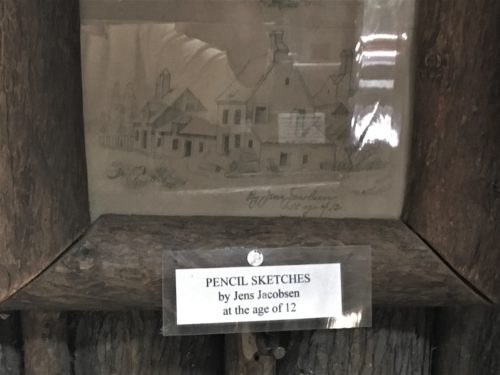
Remarkable!
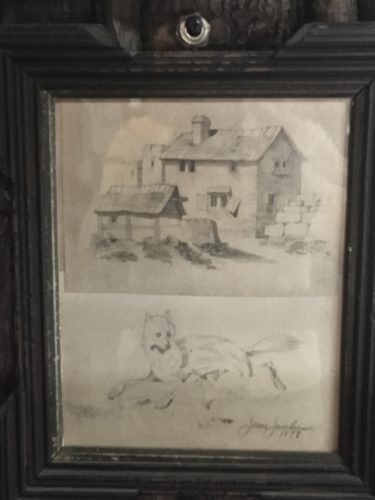
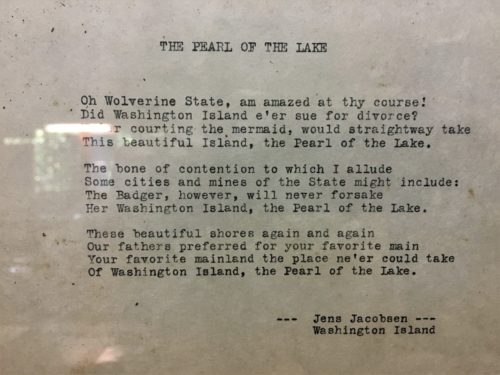
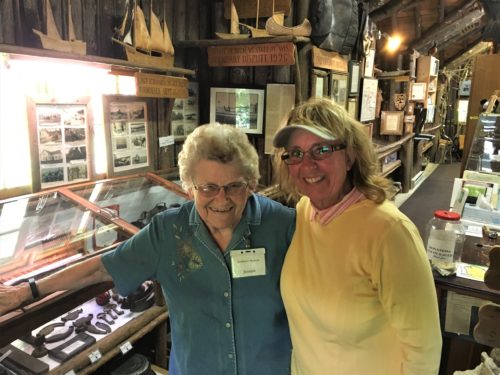
There was also a little lake on the property. : )
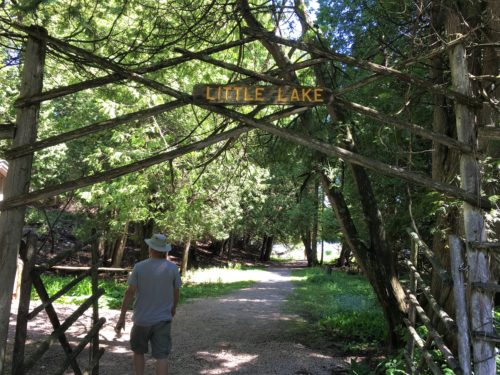
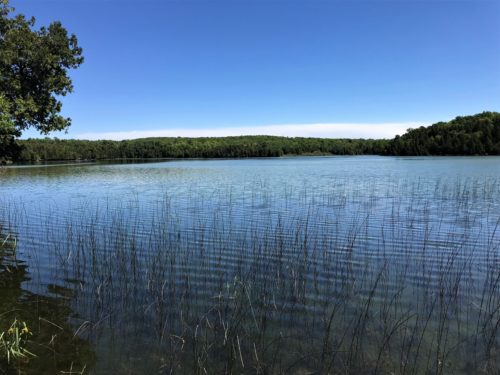
We saw a For Sale sign on a house off the museum property as we were leaving. Curiosity got the best of me and I looked it up. 2 bedroom, 1 bath, 1,000 sq ft, view of Green Bay. Guess how much? $214,000!! And it was one of the cabins built by Jens Jacobsen “years ago”. Now, keep in mind though, you also get 150’ of private beach.
A short walk from the museum parking lot was People’s Park. We visited because we could hear crashing waves. A nice little park for the locals, and we found the waves. 😊
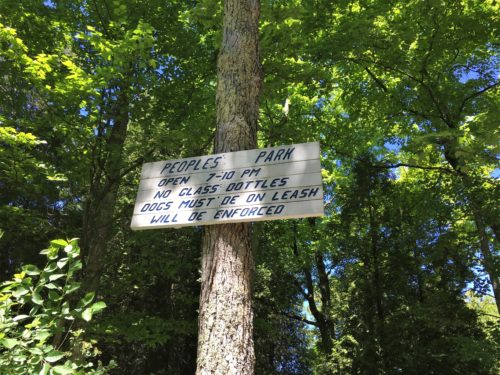
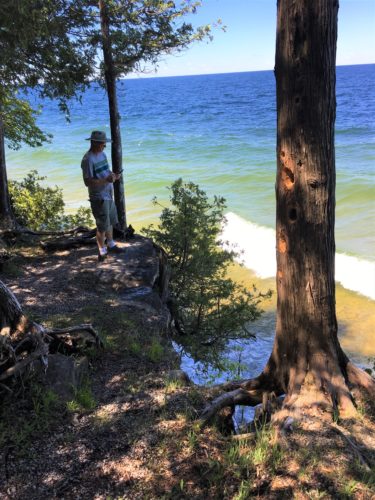
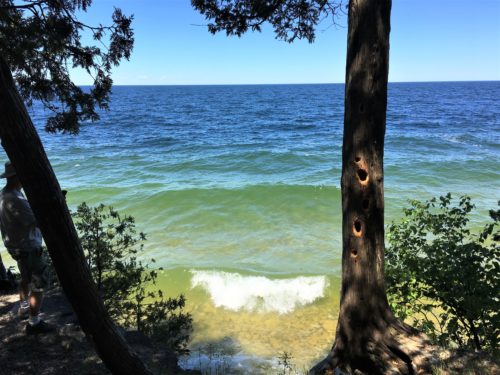
Time for lunch. The People’s Park was too shady and not much of a view, so we returned to Schoolhouse Beach. There were people there this time. Quite a few people actually. But the view was still spectacular!
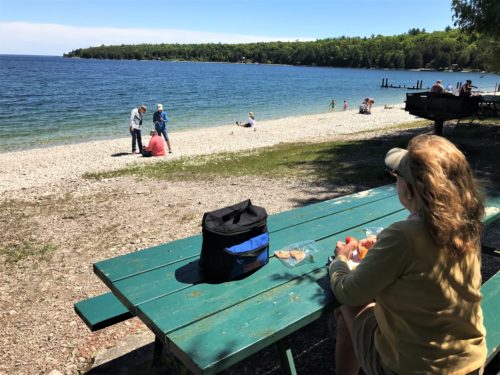
Jump in the Jeep and head for the Kafir ferry and our ride to Rock Island, where we had a pretty whirlwind tour of two (really the only two) things on the Island – the Boathouse and the Lighthouse. By the way, this entire 975 acre, 1 ½ x 1 mile Island is a State Park.
This ferry is much smaller and the ten-minute ride was a hoot! Close to the water and riding the waves, we had a blast! But remember, we’re crossing Death’s Door, so taking our very lives and placing them in the hands of the crewmen of the Washington Island Ferry Line, off we went!
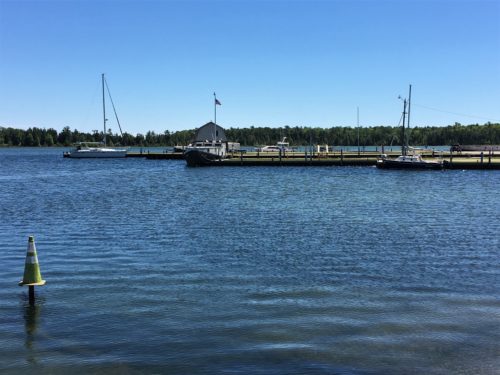
This is the dock where we caught the next ferry
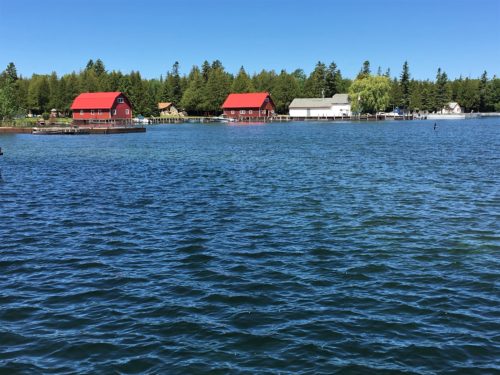
The other side of the dock.
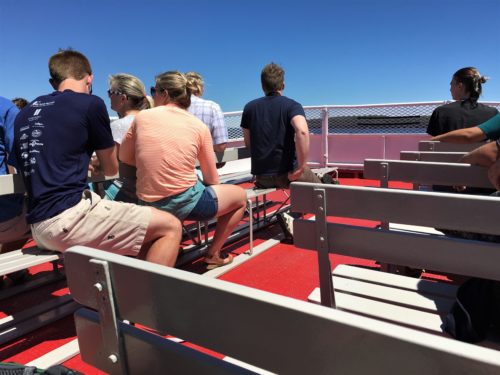
Our first view of the Island was the Boat House.
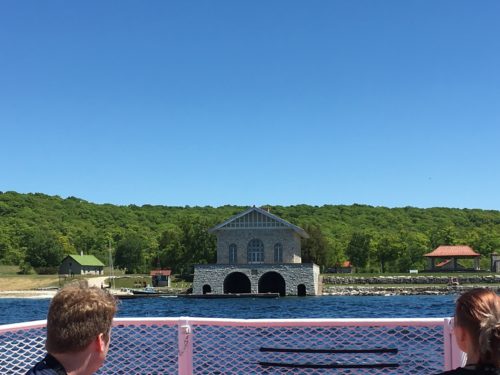
There’s the boathouse!
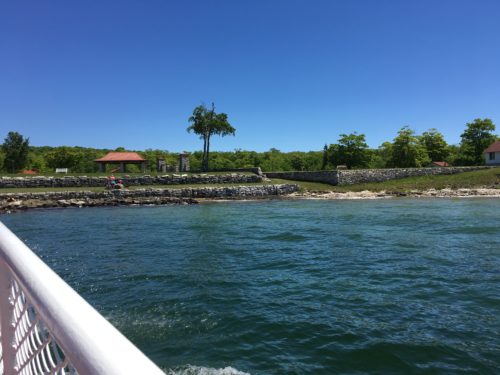
Heading to the dock.
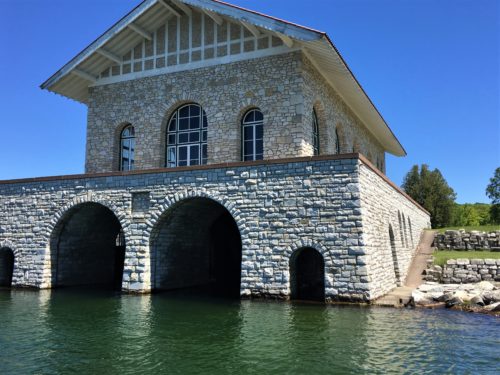
Isn’t that something !?!
What a spectacular structure! I went searching for information on this building, since we didn’t end up having much time to visit the inside. What I found was an article in a Door County paper that was quite interesting:
“This is just stunning,” a woman wrote in May 2009 as her boat approached Rock Island. “It sort of looks like a docking place for…Noah’s Ark.”
What she was looking at was the magnificent blue limestone boathouse, completed in 1929 for Chicago inventor and millionaire Chester Thordarson. It was meant as just one of the showplaces on the retreat “harmonious with nature” he was developing on the remote little island he purchased in 1910.
Instead, it was his final masterpiece. His wife did not share his love for Rock Island, so the grand home he envisioned was never built. Declining health and income were likely the reasons the 100-room hotel he sketched was never begun.
But Thordarson’s boathouse – such a treasure – became his legacy to the people of Wisconsin. Deemed one of the most historically significant buildings in the state, it is also listed on the National Register of Historic Places.
An immigrant from Iceland with a seventh grade education, Thordarson advertised in the Winnipeg News in 1923 for Icelandic men to begin work on the boathouse on the southwest corner of the island. An unattributed newspaper clipping from June 11, 1926, reports that “20 men are employed in building a $40,000 boathouse” on C. H. Thordarson’s Rock Island estate. (Remember that last figure!)
Although Thordarson hired Frederick Dinkelberg, a noted Chicago architect, to design the limestone monolith, he served as his own general contractor. The structure was anchored to bedrock seven feet below the water’s surface. All the stone – in fact, almost all the building materials, except the red tile roof that weighs 50 tons – came from the island.
The lower level of the boathouse can accommodate two 50-foot yachts. Atop it, rising 65 feet above the water, is the 40’ x 70’ architectural wonder that Thordarson called his Jewel House of Art and Nature. Referred to by others as Viking Hall, “the casino” or just the boathouse, the massive space is reminiscent of Norse myths. Rows of soaring windows, their arched tops repeating the shape of the boathouse openings below, line three walls. A wide outside balcony overlooks the water and an inside balcony stretches the width of the building.
A white oak chandelier, nine feet high and six feet wide and adorned with 20 buffalo horns, hangs from the 35-foot-high beamed ceiling. Thordarson wrote that “each horn has an electric light enclosed, mounted on a pedestal having four crystals – red, green, yellow and blue…We can get 50 different pleasant lighting effects and several that do not harmonize.”
Kirby Foss, who spent 24 years on Rock Island as a park ranger and superintendent, tells a story about the ceiling beams.
“They were Douglas firs,” he says, “ordered from Washington state, and they arrived rough sawn. Thordarson took one look at them and said, ‘I don’t like this.’ He hired Jacob Ellefson, Sr., a commercial fisherman from Jackson Harbor, to take a broad ax to them. He spent two years making the logs look as though they’d been hand hewn.”
The fireplace, big enough to roast a whole ox, was built by John Buechner of Egg Harbor, who also did much of the masonry work at the Alpine Resort, Gordon Lodge and the Baileys Harbor Town Hall. Etched into a steel strip above the hearth in runic characters is: “Fire is one of the best things for the sons of men and so is the sign of the sun if a man manages to keep health and live virtuously.”
To create the unique furnishings he pictured for the great hall, Thordarson brought 29-year-old Halldór Einarsson from Iceland. Over several years, he built and carved many ornate oak pieces, including two huge tables, 20 straight-back chairs, king’s and queen’s chairs, a desk and chair set, a settee and a dictionary stand. Each piece was elaborately decorated with scenes from Norse mythology. The 1999 book, Valhalla in America: Norse Myths in Wood at Rock Island State Park, Wisconsin, by Douglas and Sharon Rossman, pictures each of the items with its runic title and tells the story the mythic scene depicts.
The primary reason Thordarson built the boathouse was not to house boats, but to provide a secure home for his vast and valuable library. As a young man, earning $4 a week in a factory, he religiously saved $1 toward the purchase of books. After the invention of the first million-volt transformer and other inventions that made him wealthy, he acquired a library of 11,000 rare volumes devoted to Icelandic history, botany, natural history and ornithology. His collection included: one of only two known copies of William Copland’s The Craft of Grafting and Planting of Trees from 1560; the only known copy of A Boke of the Propertyes of Herbes, printed in 1540; and a 1564 copy of H. Baker’s The Wellspring of Sciences (older by 10 years than the copy in the British Museum). Of special value were his Coverdale Bible and four Audubon folios. In 2010, a similar Audubon set was sold at Sotheby’s in London for approximately $11.5 million. All of them were displayed in cases lining the balcony of the boathouse.
Thordarson died in 1945 at age 77. Although Yale had offered him an honorary doctorate in exchange for a bequest of the books and the bishop of Iceland’s state church urged him to remember the University of Iceland, his will specified that the trustees of the University of Wisconsin had a one-year option to purchase the library. For the remarkable price of $170,000, they acquired the books in 1946 as the basis of their rare book collection in Madison.
After the state bought the island as a park in 1965, paying $175,000, the furniture was sold to Douglass Cofrin of Shorewood for $50,000. He used it for more than 20 years before donating it to The Clearing, where it was stored until 1991, when Mark Eggelson, then park manager, discovered it and arranged for it to be purchased and returned to the boathouse.
The boathouse is open every day during the park season and other times by arrangement with the ranger, when people arrive by private boat.
“It’s in wonderful condition,” Foss says. “The original furniture is roped off, but you can spend time in the room. You can even hold a wedding there, although it’s a public space and can’t be reserved.”
Thordarson’s ashes rested on a shelf in the boathouse for 20 years before they were finally interred on the island. It’s easy to imagine that his spirit still lingers in the structure he loved that ended up costing not $40,000, but between $250,000 and $300,000 – $34 to $41 million in today’s economy!
But first (before checking out the boathouse), we booked it to the Pottawatomie Lighthouse. Knowing we only had two hours on the Island, or wait an additional two hours for the next ferry – Blaine wanted to get there before the others, and promised me we could stop for pictures on the way back. It’s a good thing we outran them all, because we were the last to make it for a surprise (to us) tour of the lighthouse.

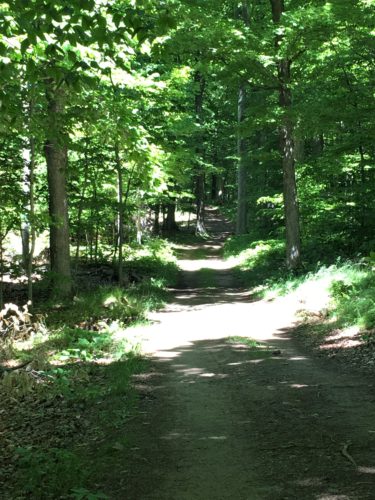
It was a mile and a quarter walk to the lighthouse from the dock.
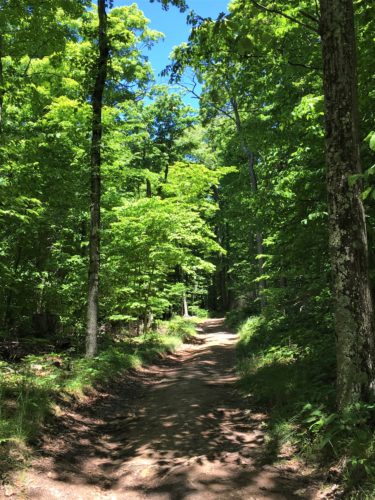
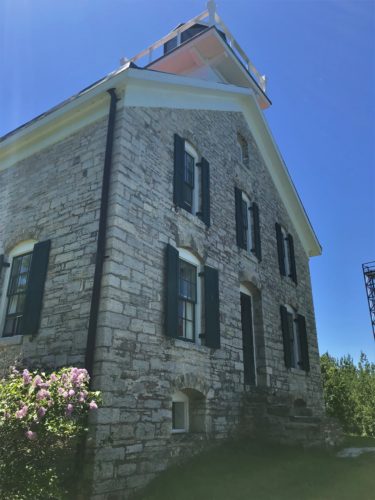
There wasn’t a great place to take a picture.
This is the best we got.
The Lighthouse tours are given by resident Docents. They actually live in the lighthouse for a week and give periodic tours. 19 weeks are in a season, and there are 19 Docents. They review applications and decide who to accept.
We were blessed to have the husband (I never got his name). He told us the tour would be about 15 minutes, and I heard his wife (who had just finished a tour) say under her breath, “Well, that’s a bold-faced lie.” 😊 Anyway, he was very interesting – and took over 30 minutes. The original light fell apart, but this building has been here for over 150 years. The one we were in has been restored to reflect the way it would have been in the 1910 era. There’s no heat and no electricity. Water comes from a cistern and solar pump. They’ve put in a very small kitchen with a tiny two-burner propane stove for the Docents. They must remove the antique quilts before sleeping in the beds.
The first light was built in 1836, but was of poor construction and literally fell apart. It was torn down in the 1850’s and this building was completed in 1858 and continued in operation until 1988 when a new steel tower was put up and an automated light put in.
The light had a nine-sided tower and a fourth order Fresnel lens. Now, I don’t know what all that means, but I guess it’s pretty significant. For one thing, nine sides refers to the glass that goes around the tower. An odd number makes construction more difficult, but the thought is that it was done so no pane of glass would be directly opposite another. The other thing of note is that in 1988, the lens was carefully packaged up and put in the basement for storage. At some point, it was stolen and has disappeared! The Docent’s theory is that someone from the government took it. It’s probably stored with Indiana Jones’ lost ark. 😊

This the replica lens. Since the original was stolen, “they” paid $25,000 to have this plexi-glass one made.
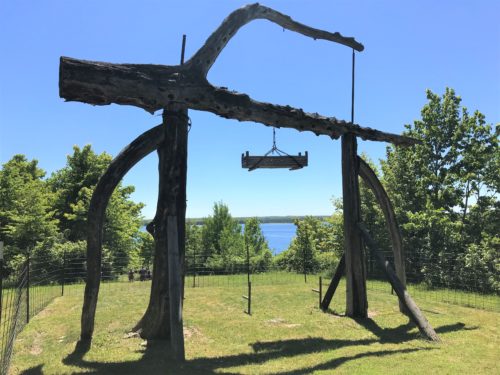
We know this is a gateway onto the lighthouse property. What we don’t know is what that basket is hanging there for.
Didn’t think to ask the Docent until it was too late.

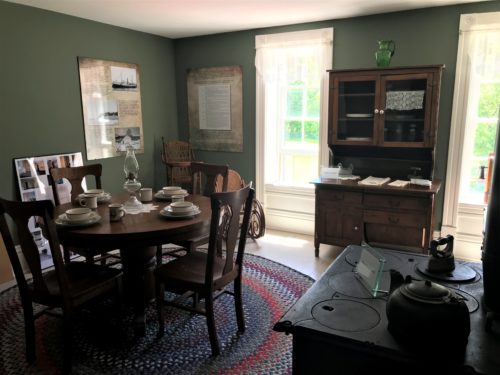
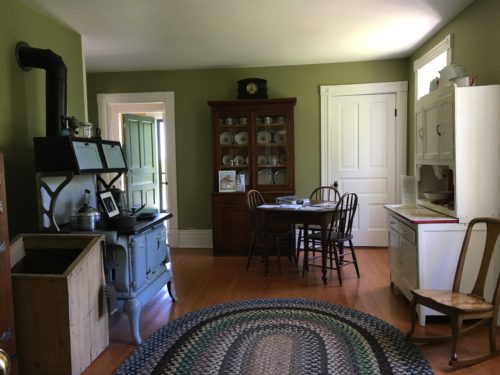
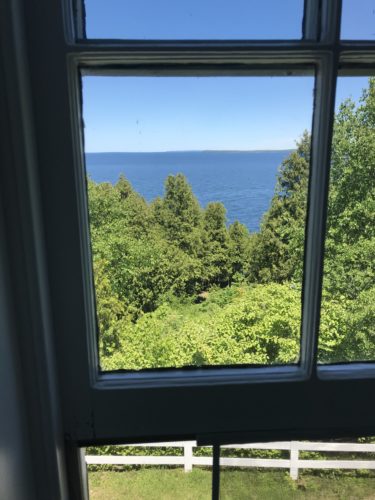
They sure have some spectacular views in this house!
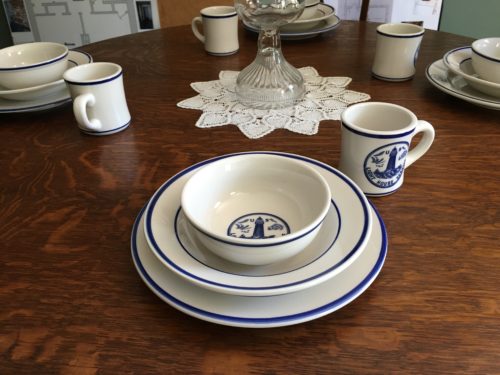

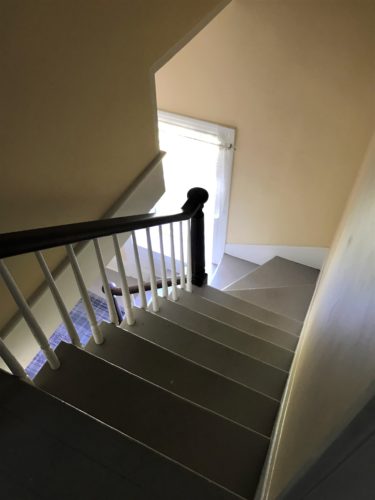
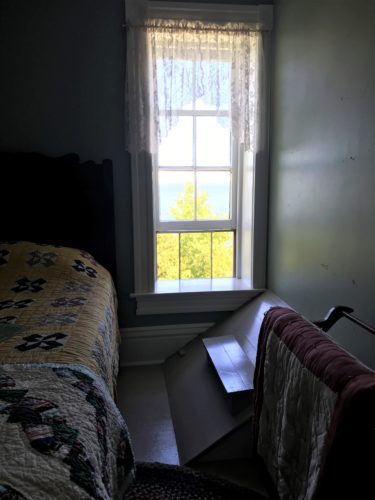
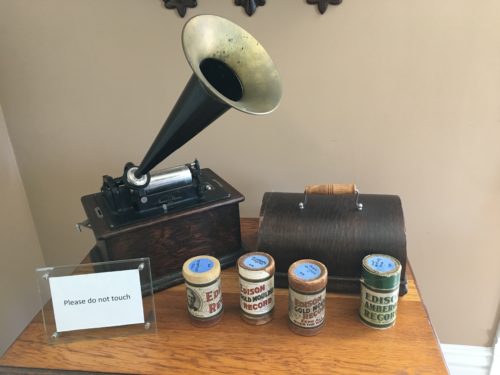
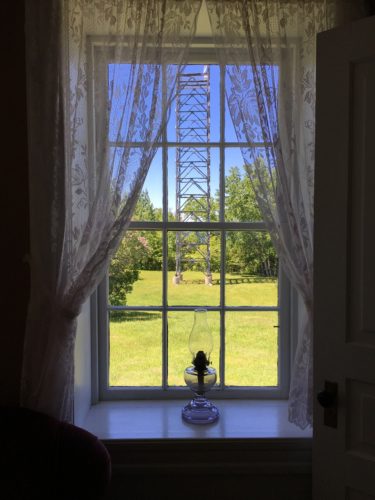
The steel tower out there is the new light.
It has no charm whatsoever.
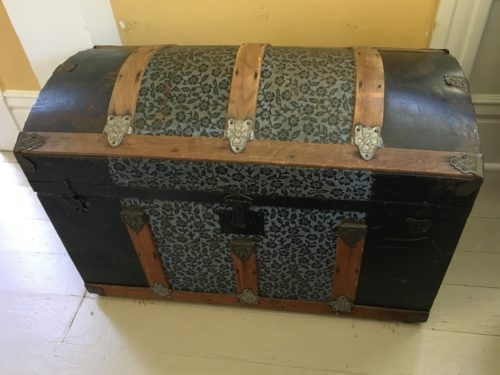
I used to have a trunk just like this!
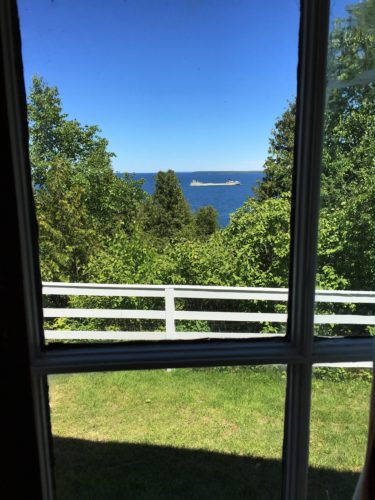
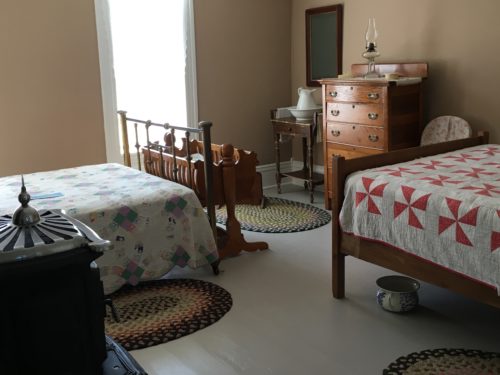
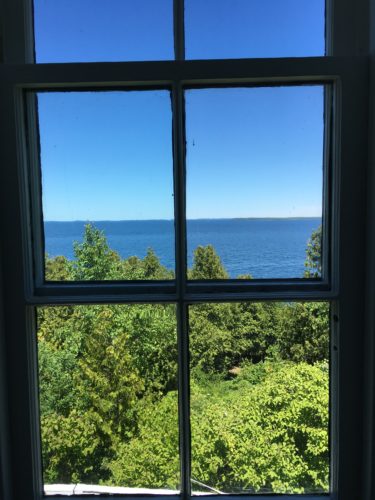
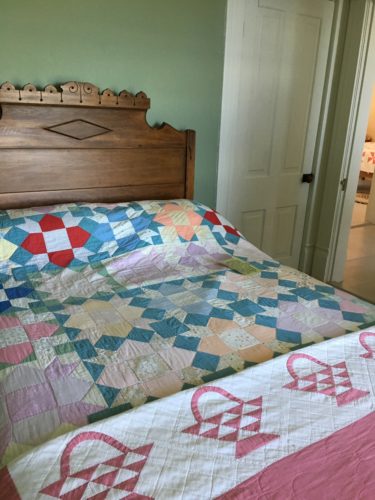
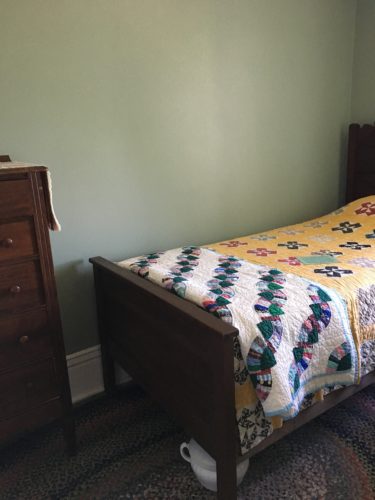
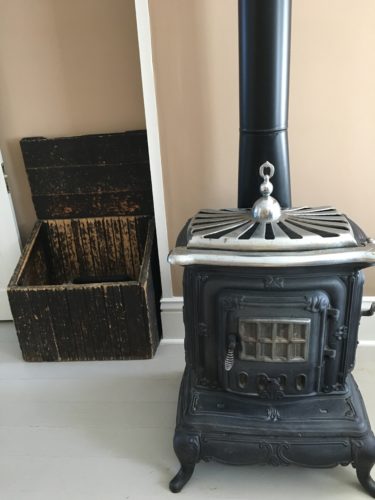
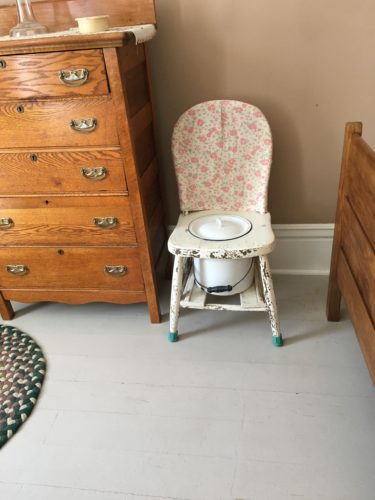
I don’t know about you, but I’m soooooo thankful for indoor plumbing!

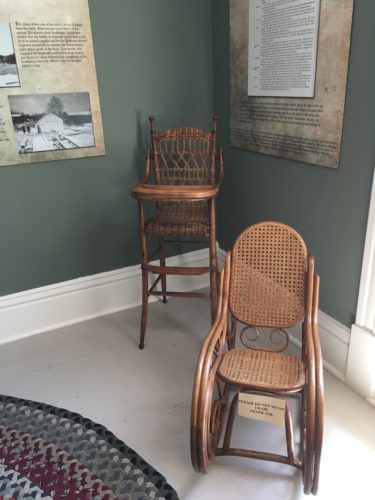
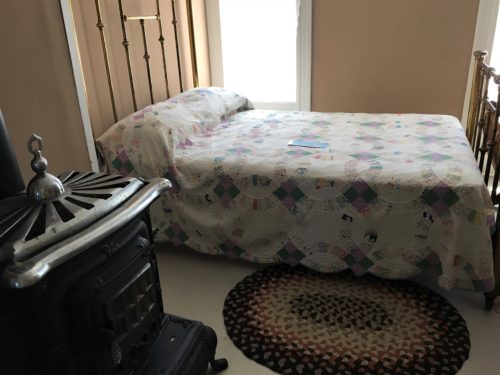
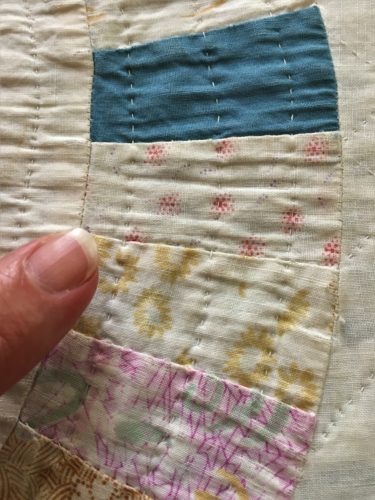
M.y index finger, just to give you some perspective
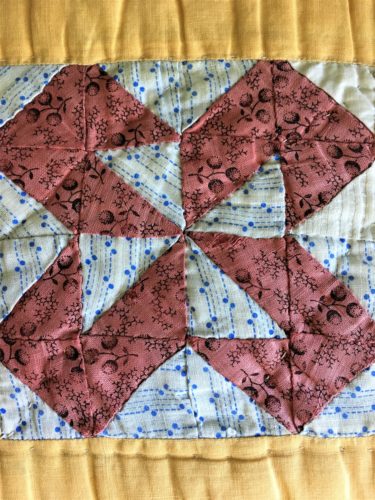
Isn’t this incredible!
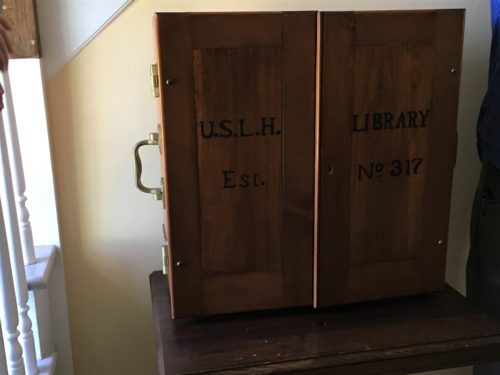
This was really interesting – The government kept trunks like this to pass around to the various lighthouse keepers’ residences.
It’s a library! It had about 3 shelves of books. and while the keepers couldn’t request anything, if they had kids, they tried to pass along children’s books.
This one is numbered 317, so there were at least that many in circulation.
The keeper we were told the most about was a man named Frank Sawyer – the first keeper of the new light. He was only there for two years, until 1861 when he joined the Civil War where he served faithfully. Frank carved his name into the rocks above the back door.
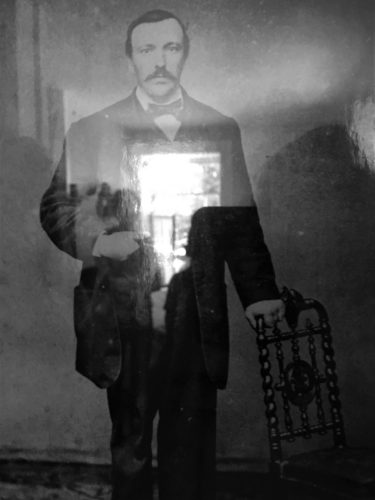
This is Frank Sawyer
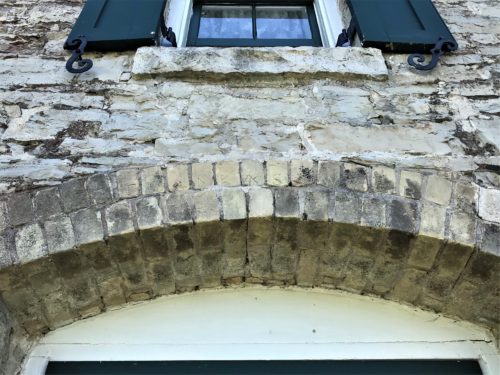
If you look close, you can see Frank’s name carved in the top curved row of bricks.
The keeper who arrived in 1870, William Betts, served for sixteen years and had 9 children in this tiny place!
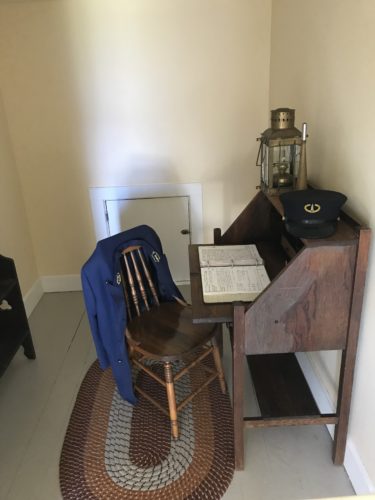
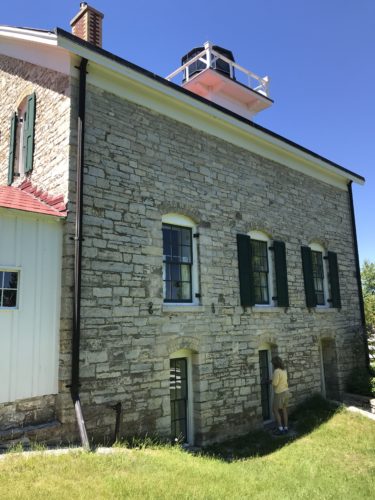
Peering into the classroom in the basement.
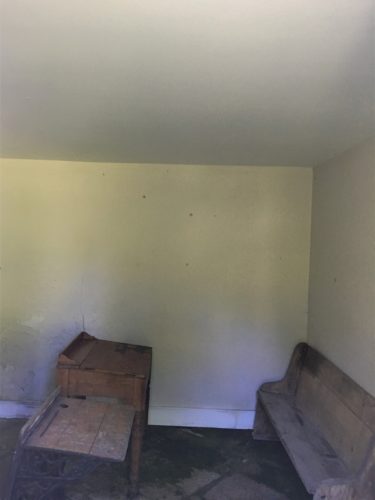
Part of the classroom.
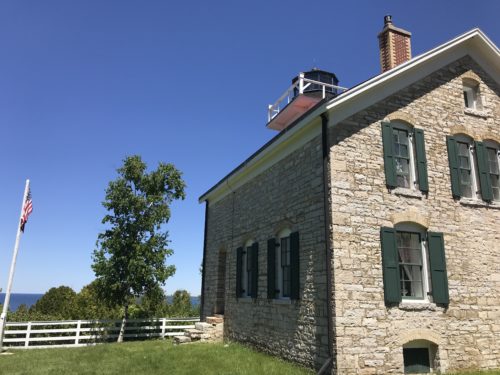
All of the wood and rock for these buildings came from the Island.
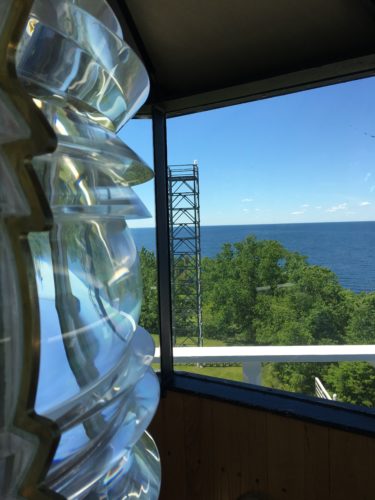
The old and the new . . .
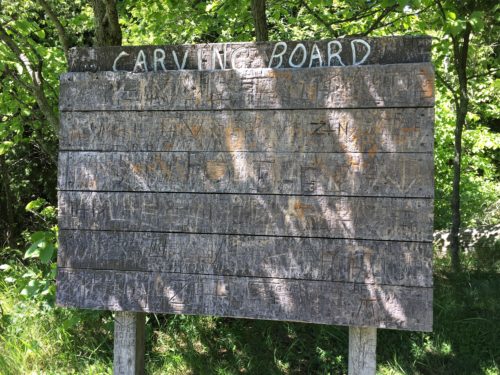
This was interesting, but I think they need a new one.
Time to move on. Oh! But first, I forgot to tell you that no shoes are allowed on the tour. You either go barefoot, stocking feet, or put booties over your shoes.
Now, there’s something you don’t see every day!
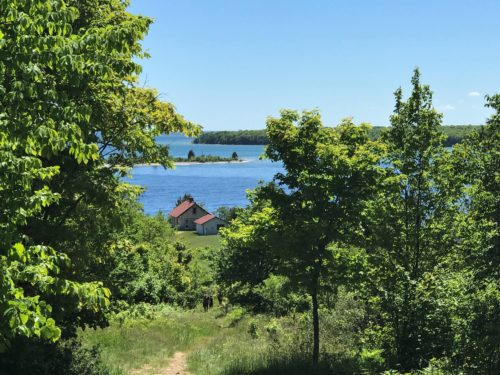
Back down the hill to the boathouse.
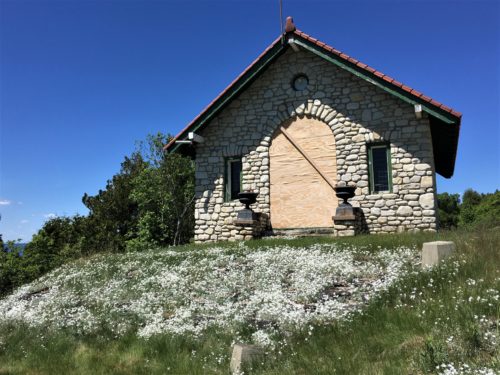
I don’t know what this building was or currently is, but it reminded me of “Heidi”. : )

Isn’t this stuff gorgeous?!?
It’s called Snow-in-Summer and it’s native to the alpine regions of Europe.
See? Heidi! Just like I said!
Mr. Thordarson brought it over in the 1920’s or 30’s.

Love it!
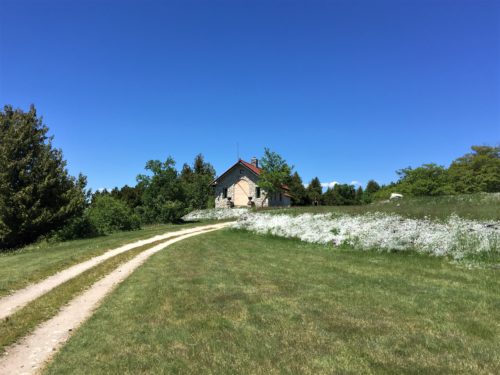

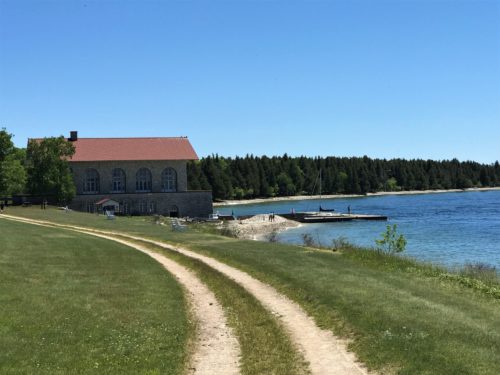
The boathouse is something else! It’s hard to imagine that a building to store boats could be included on the National Registry of Historic Places, but after seeing it, I sure can! It’s in pristine condition, in a gorgeous setting, and the building is spectacular both inside and out.
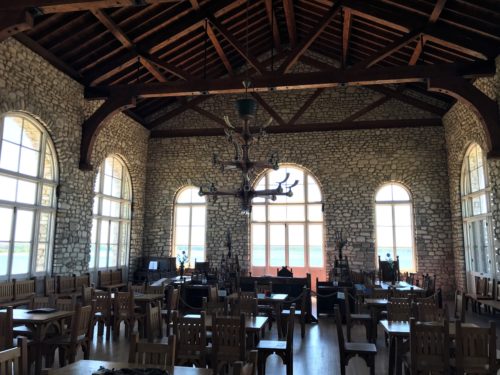
The inside is just as spectacular as the outside!
I found this information on Mr. Thordarson from various sources on the internet:
Born Chester Hjortur Thordarson in 1867, Thordarson’s family immigrated to the United States from Iceland in 1873. They settled in Milwaukee, where Thordarson’s father soon died. Shortly thereafter they moved to Dane County, then to Shawano County, and, when Chester was 13, to the Red River Valley in North Dakota. Thordarson received little formal education and finished the fourth through the seventh grades in two years after he moved to Chicago at the age of 18 to live with his sister. Between the ages of 20 and 27, Thordarson worked in several electric companies in Chicago and one year for a streetcar company in St. Louis. In 1895 at the age of 27 and with seventy-five dollars in savings, he founded the Thordarson Electric Manufacturing Company in Chicago.
Thordarson, who invented the electrical transformer in 1904, continued to work as an inventor (acquiring 115 patents) and manufacturer of electrical apparatus.
In 1910 Thordarson bought Rock Island in order to enjoy “…wild plant and animal life in undisturbed wilderness,…”
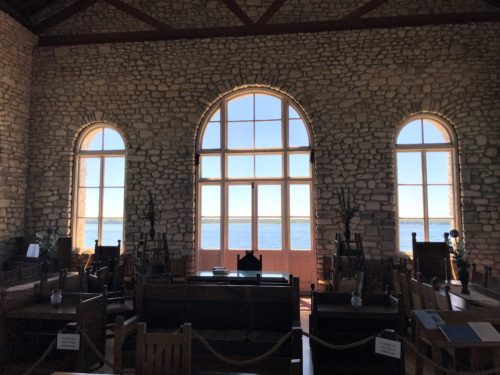
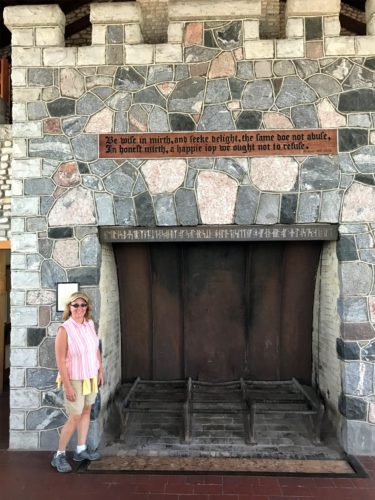
Fireplace large enough to roast an ox!
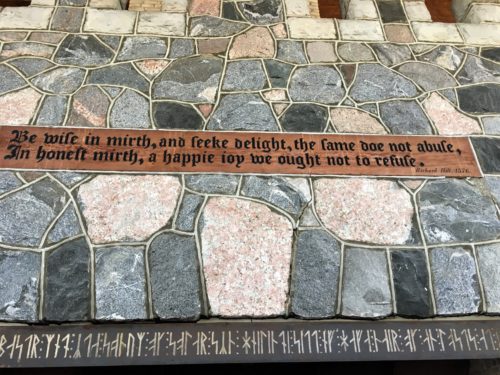
By Richard Hill in 1576.
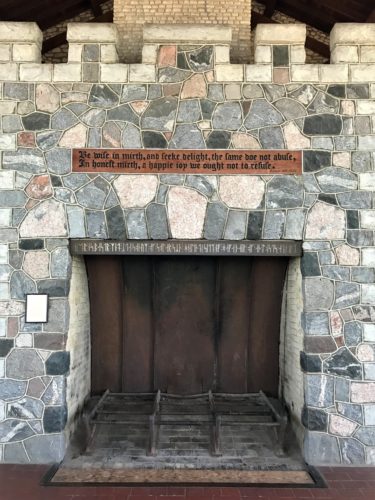
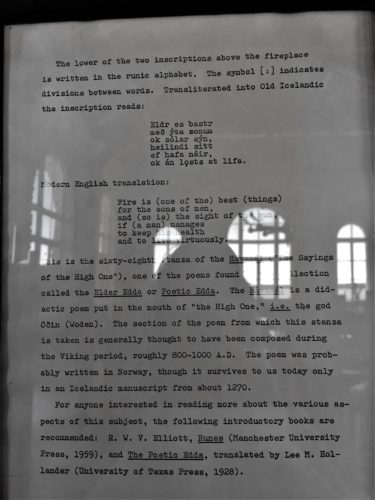
Information on the fireplace.
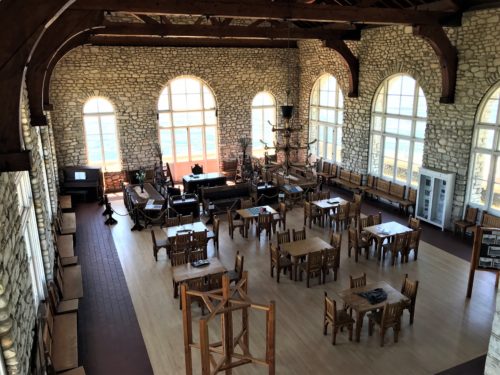
35′ ceiling
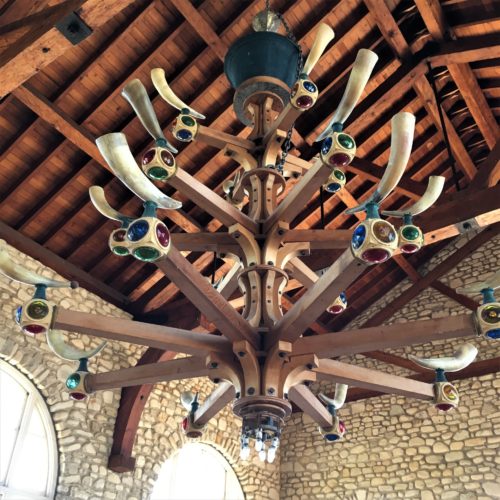
Jeweled 9′ x 6′ chandelier.
The jewels are designed to produce lighting effects
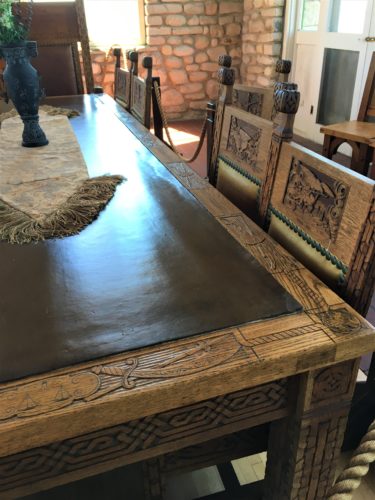
Incredible art!

Information on the wood carvings.
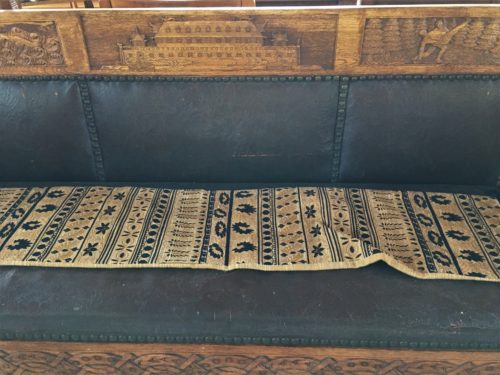


Chester Hjortur Thordarson
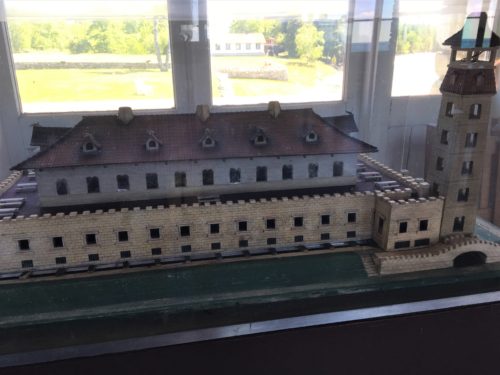

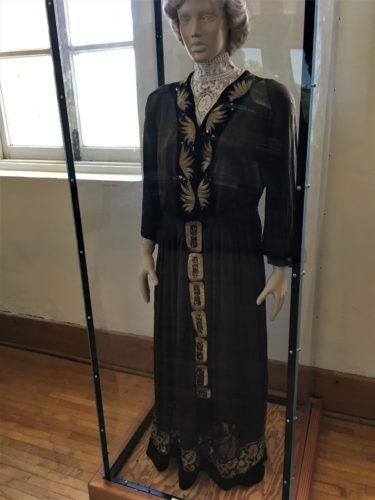
Mrs. Chester Thordarson in her wedding dress
(Icelandic Costume)
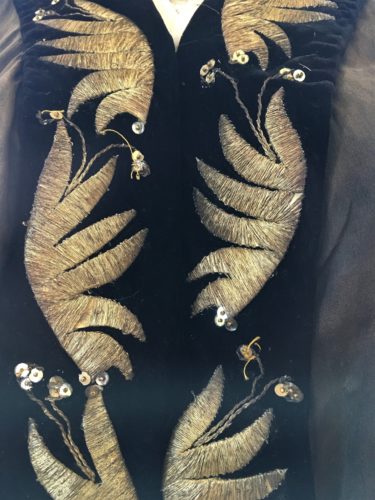
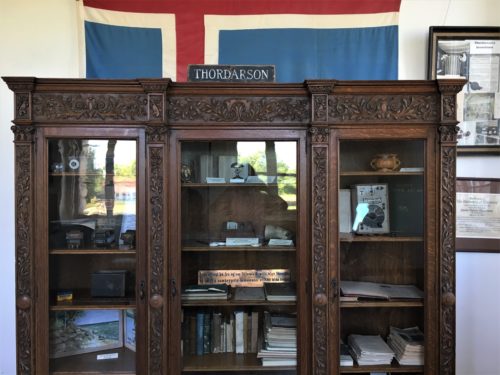
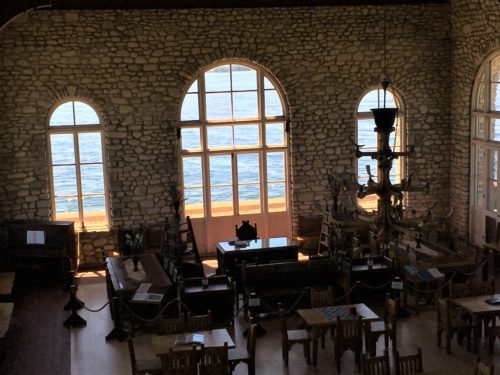
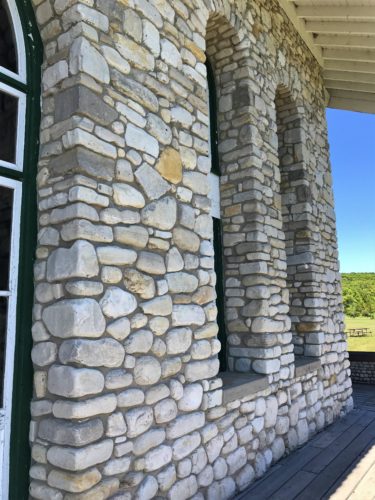
Remarkable place. Remarkable man. What a blessing that this place was left to the State!
Now there’s something you don’t see every day!
As we were waiting for the return ferry, someone pointed out a garter snake that was up against a wall at the boathouse. As Blaine was taking a picture, I discovered a toad around the corner.
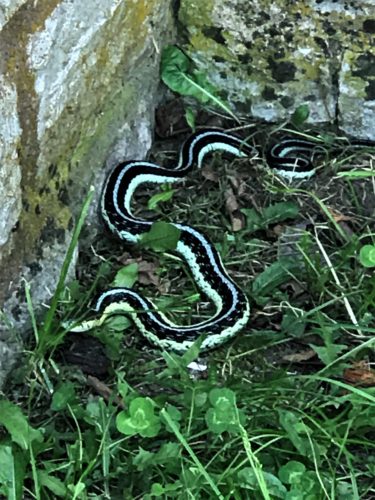
Isn’t it pretty?
Never would’ve guessed it was a garter snake, tho. I had to look it up.

This guy was huge!
About the size of a kiwi – or even a little bigger.
We went to look under the boathouse and then I realized I hadn’t taken a picture of the welcome sign yet. I could see the ferry on it’s way, so I scurried around the boathouse to the sign.
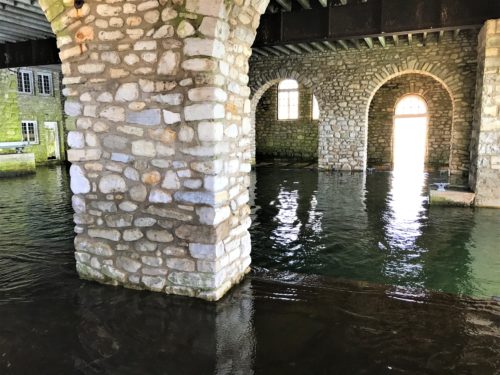
Under the boathouse.
Does this look like it could fit two 50′ yachts?
That’s a 65′ ceiling!
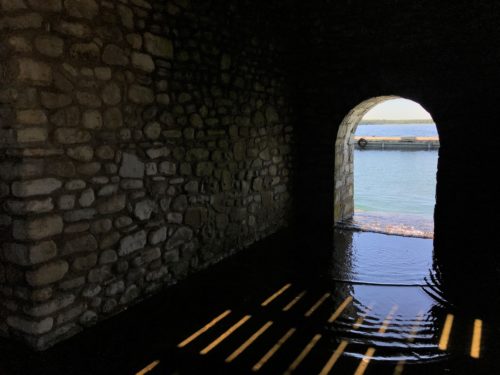
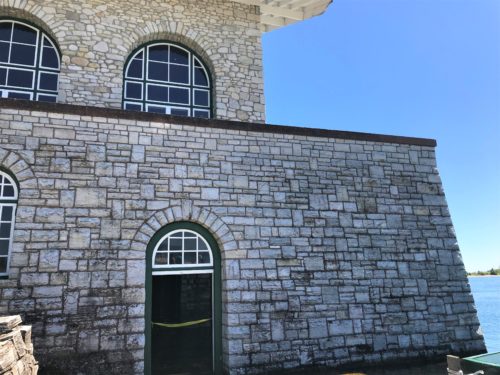
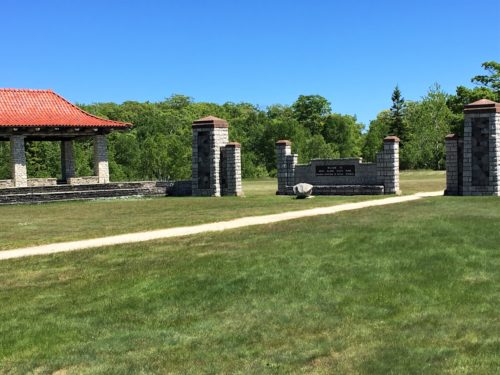



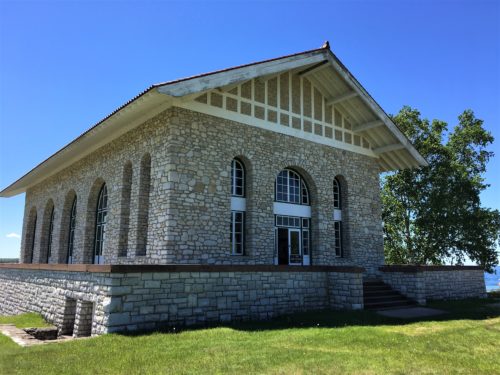
On the way back, I stopped to check out the snake – – just because. Guess what I found!

The snake has the toad’s leg in it’s mouth already!
I wondered why the toad wasn’t struggling at all and immediately thought – toxin. Turns out a garter snake is able to paralyze it’s victim with a single bite. Well that explains it!
Now there’s something you don’t see every day!
Back across Death’s Door on a wild ride . . . .
(the video doesn’t really show how fun it was!)
. . . . and we completed our tour with a drive around the rest of Washington Island. There wasn’t much to see, but we did stop at the Sand Dune Park to check it out – – the name sounded interesting. Sure enough, there were dunes!
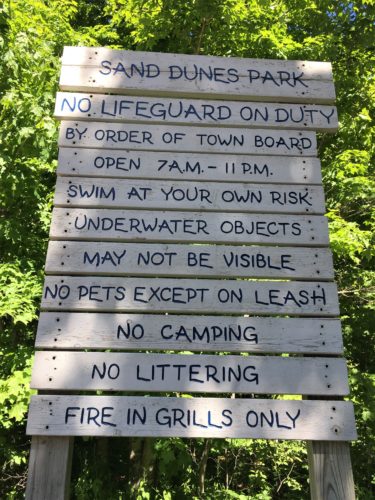
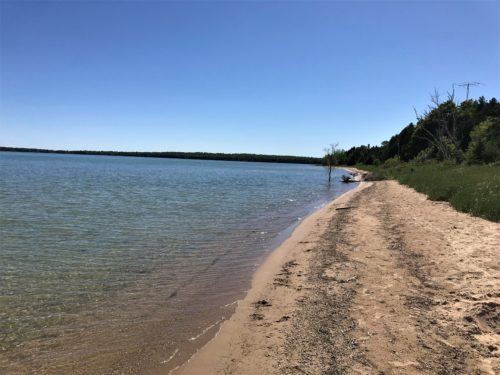
The beach at Sand Dunes Park
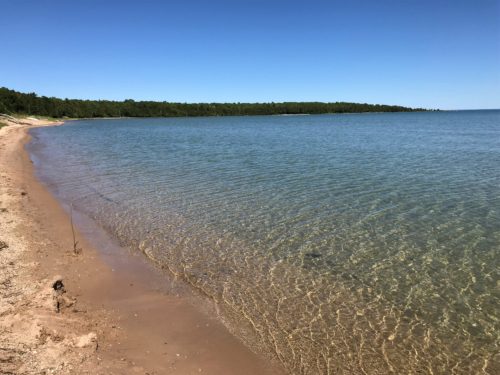
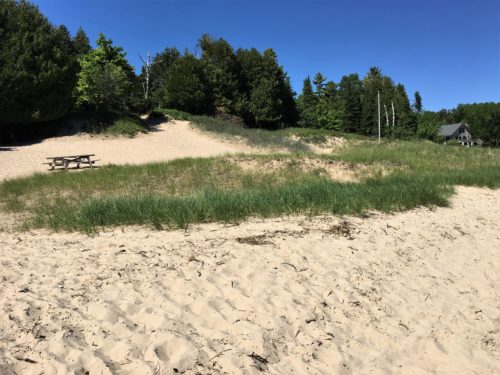

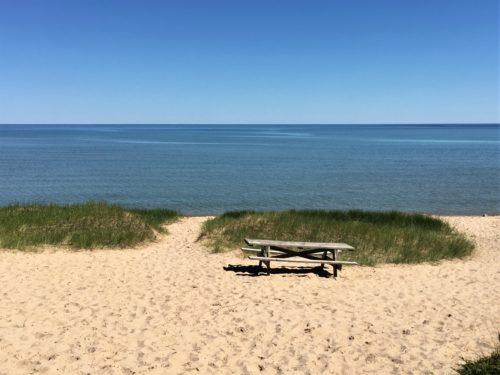
Onto the ferry and back to the Peninsula for dinner to end our day.
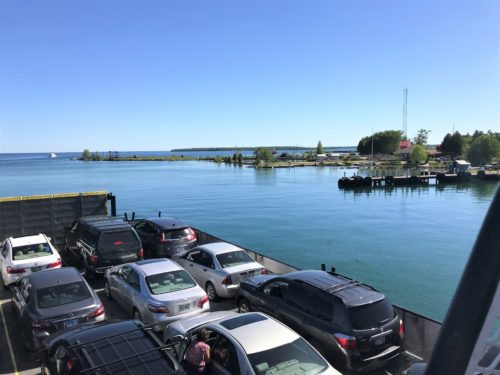
The ferry back to the Peninsula. As I said before, they really know how to pack us in!
We were waiting in line, when a guy came to the window and said, “You look like a guy who can parallel park.” And he motioned us ahead of others and sure enough, they paralleled him right into a tiny spot along the right side.
We didn’t have a particular place in mind, so we Googled restaurants and eventually agreed on a restaurant in Sister Bay called Al Johnson’s Swedish Restaurant. One of the most unique restaurants we’ve ever seen, let alone eaten at!
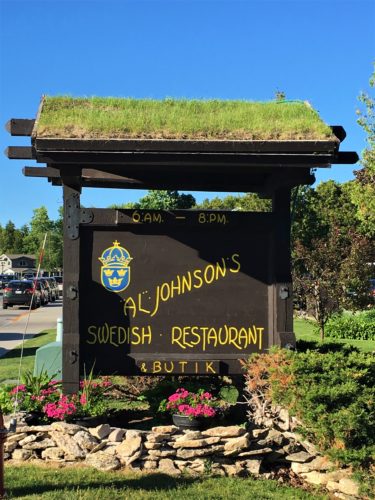
Every morning, they bring goats from their farm and put them on the roof of the restaurant. A roof covered in real grass! In the evening, they take them home.

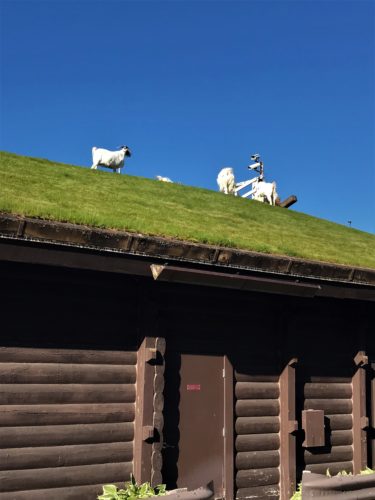
See that camera?
They have a goat cam so you can watch them anytime you want! During business hours, of course. And only May – September.
Go to aljohnsons.com.
Now there’s something you don’t see every day!
Inside, all the staff we came in contact with have accents. I’m thinking exchange students? New immigrants? I don’t know. And they’re all dressed in traditional Swedish clothing.
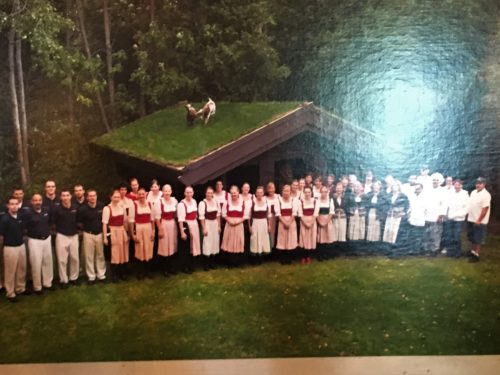
This is how the staff dresses.

In the women’s restroom.
Now there’s something you don’t see every day!
The food was excellent and plentiful! With the exception of the “array of Swedish breads”. Most of it was hard and dry – more like crackers really. But they weren’t bad with the lingonberries piled on top, which I think, is what you’re supposed to do.
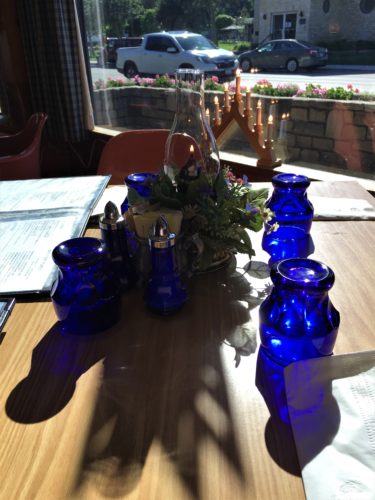
Isn’t the glassware pretty?

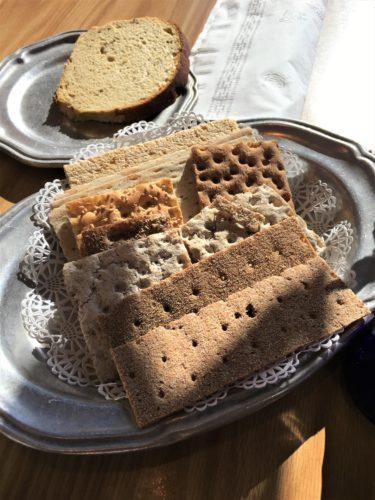

Now there’s something you don’t see every day!
If you’re like me, you’re now wondering ‘what in the world is a lingonberry?’ Here’s what I found out. Lingonberries are found readily in Scandinavian countries. They grow wild (like black raspberries around here) and resemble cranberries, but they have a tart/sweet taste. If you soak them in water with just a bit of sugar, they form their own sauce (kinda like jam, but not as thick). This is what we were eating, and it was yummy!
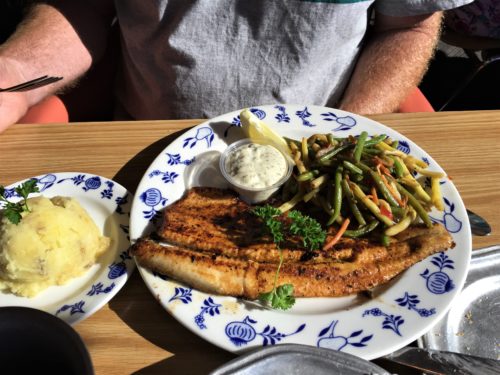
Blackened White fish, “vegetables”, homemade mashed potatoes.

Swedish meatballs, veggies and potatoes.
After dinner, we strolled around Sister Bay Harbor and Blaine defied the authorities – – – again.
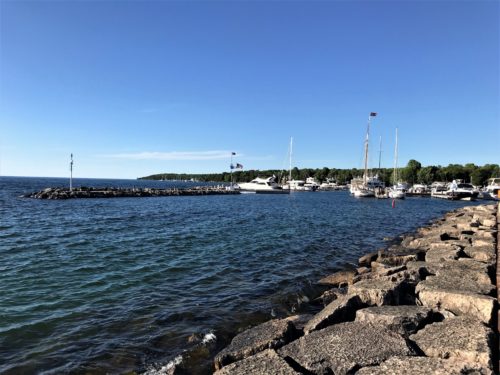

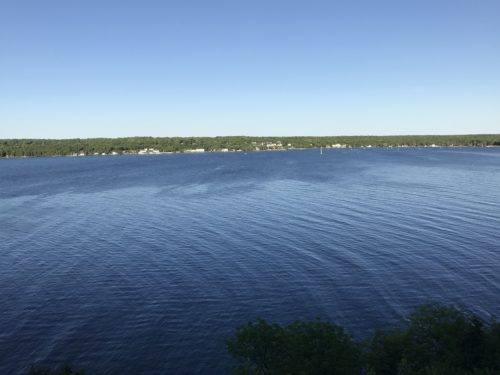
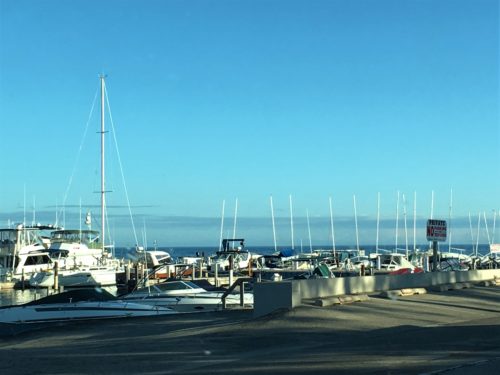
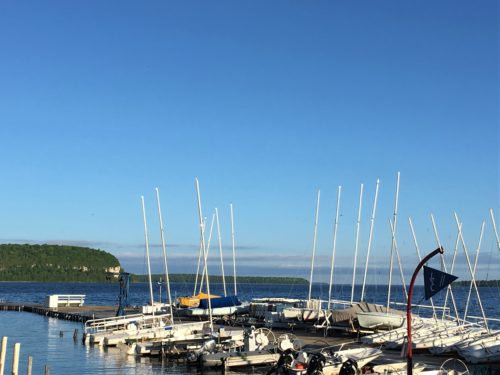
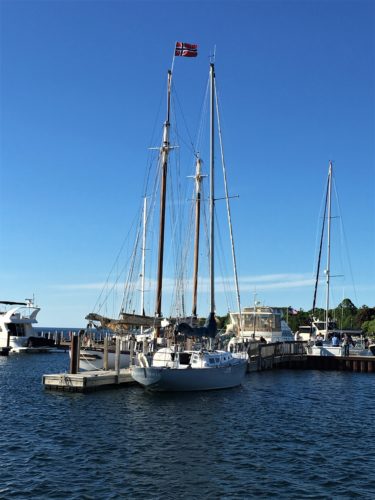
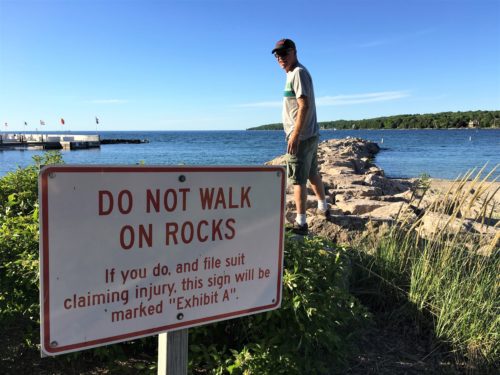
Now there’s something you don’t see every day!
The sign. Not Blaine’s little boy dare me attitude. : )
